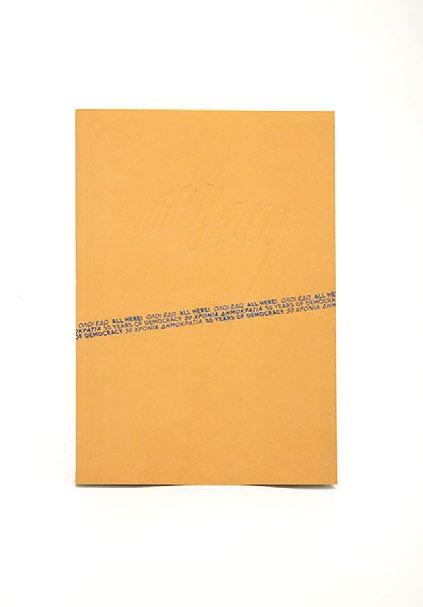the MOMus magazine
No 2 ---- Q2 2025
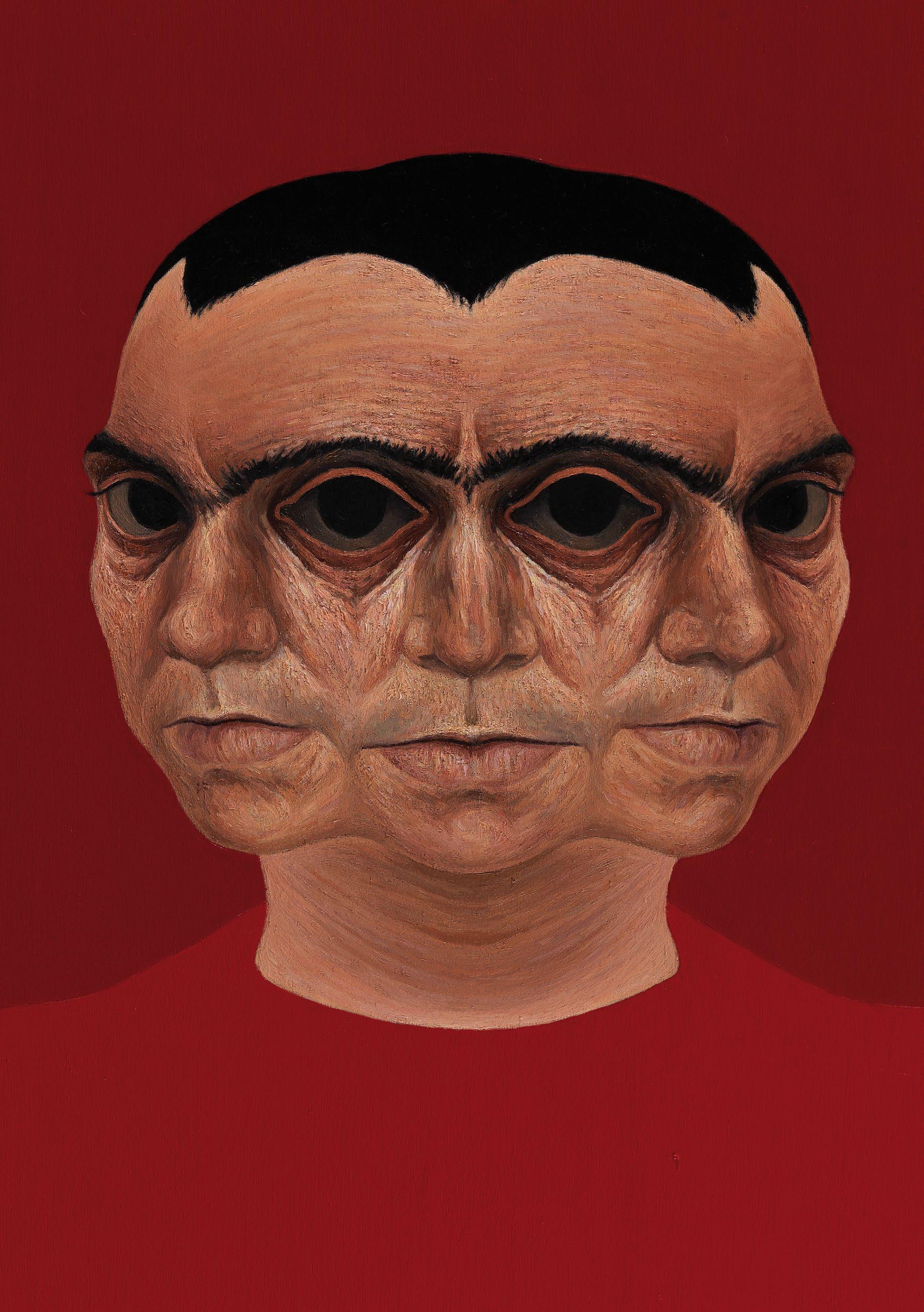

No 2 ---- Q2 2025

The wondrous and the unexpected, the ambiguous and the enigmatic, these are all fundamental elements, lying at the heart of the exhibition a Cabinet of Curiosities at MOMus-Museum Alex Mylona in Thiseio, Athens.


@MOMusMuseums
@MOMusModern
@MOMusContemporary
@MOMusPhotography
@MOMusExperimental
@MOMusAlexMylona

ThessPrint S.A.



The MOMus Magazine is a quarterly publication available free of charge at MOMus museums in Thessaloniki and Athens, as well as at selected distribution points and online. Any reproduction, redistribution, or adaptation of the magazine’s content, whether in full, in part, summarized, paraphrased, or otherwise rendered by mechanical, electronic, photocopying, or recording methods is strictly prohibited without prior written consent from the publisher, in accordance with Law 2121/1993 and applicable international legal provisions in Greece.
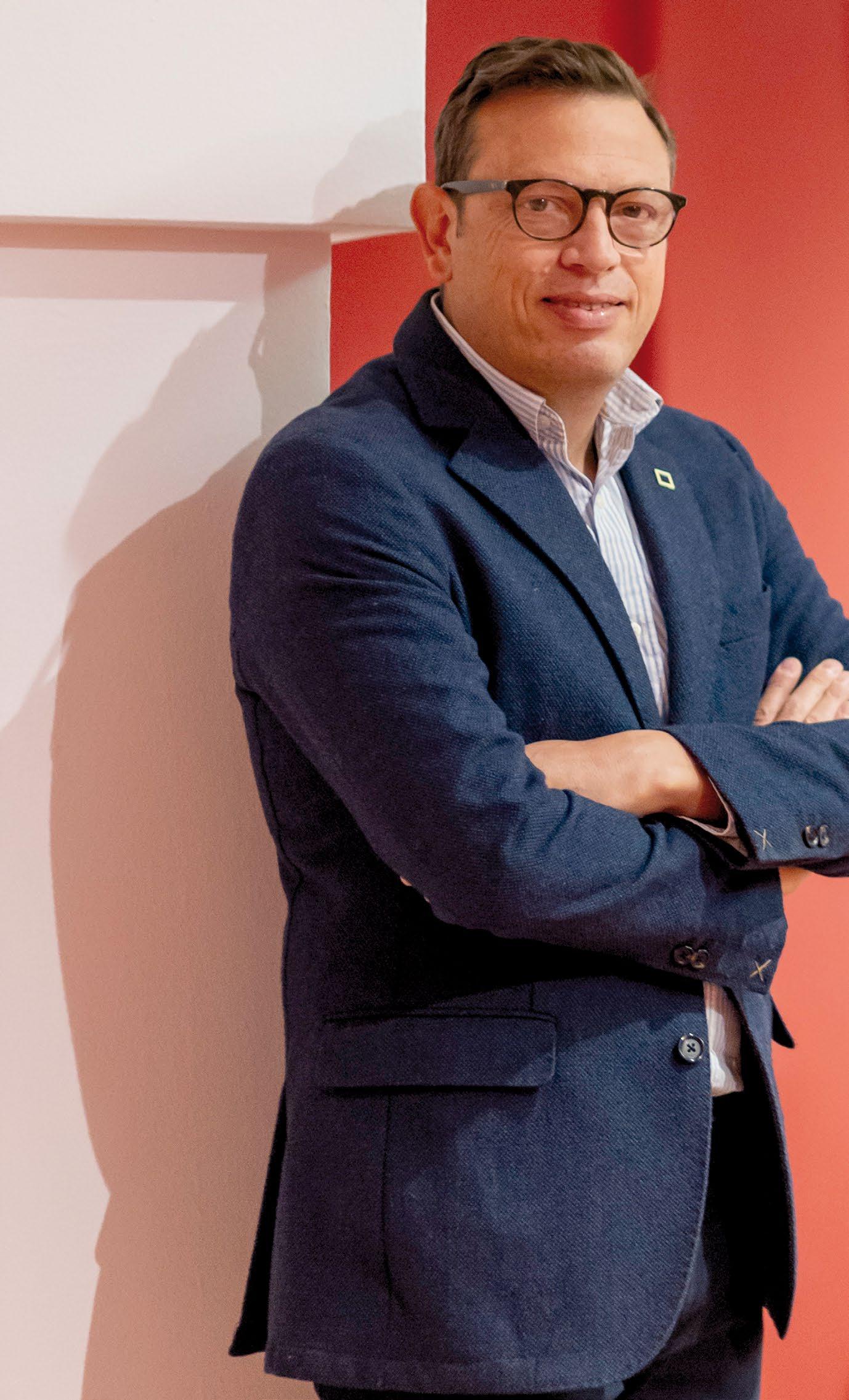
With five museums in Thessaloniki & Athens, and home to the internationally acclaimed Costakis Collection among its priceless collections, MOMus is one of Greece’s most important institutions for contemporary culture. Its mission? To preserve, promote, and elevate contemporary artistic creation.
In Greece, contemporary culture is often measured against the grandeur of the Hellenistic and Byzantine periods, and undeniably so, given the profound artistic and cultural achievements of these eras. We sometimes forget that the artifacts we now admire in archaeological museums were once the contemporary art of their time. These were the works that survived the passage of centuries to become treasured pieces of world heritage. Countless other creations however such as different styles, themes, and artistic voices faded into oblivion, lost to history.
At MOMus, we recognize our responsibility to honor the past but also engage with the present and influence the future. Our role is to actively support contemporary artistic production, promote works that we believe deserve to be preserved, discussed, and passed down to future generations. Whether these creations will ultimately withstand the test of time and join on the leagues of cultural heritage is something only the future can determine. However, one thing is clear: if we remain fixated on the past, we risk moving blindly into the future, inevitably stumbling along the path.
In recent years, our commitment to championing contemporary culture has been met with growing enthusiasm from the Thessaloniki community. The impressive rise in our visitor numbers places MOMus second only to the city’s iconic Archaeological Museum, an accomplishment that not only marks our progress but also signals a collective desire to welcome the future.
At MOMus, we choose to move forward with confidence and optimism, keeping our focus on new artistic creation. n
MOMus president
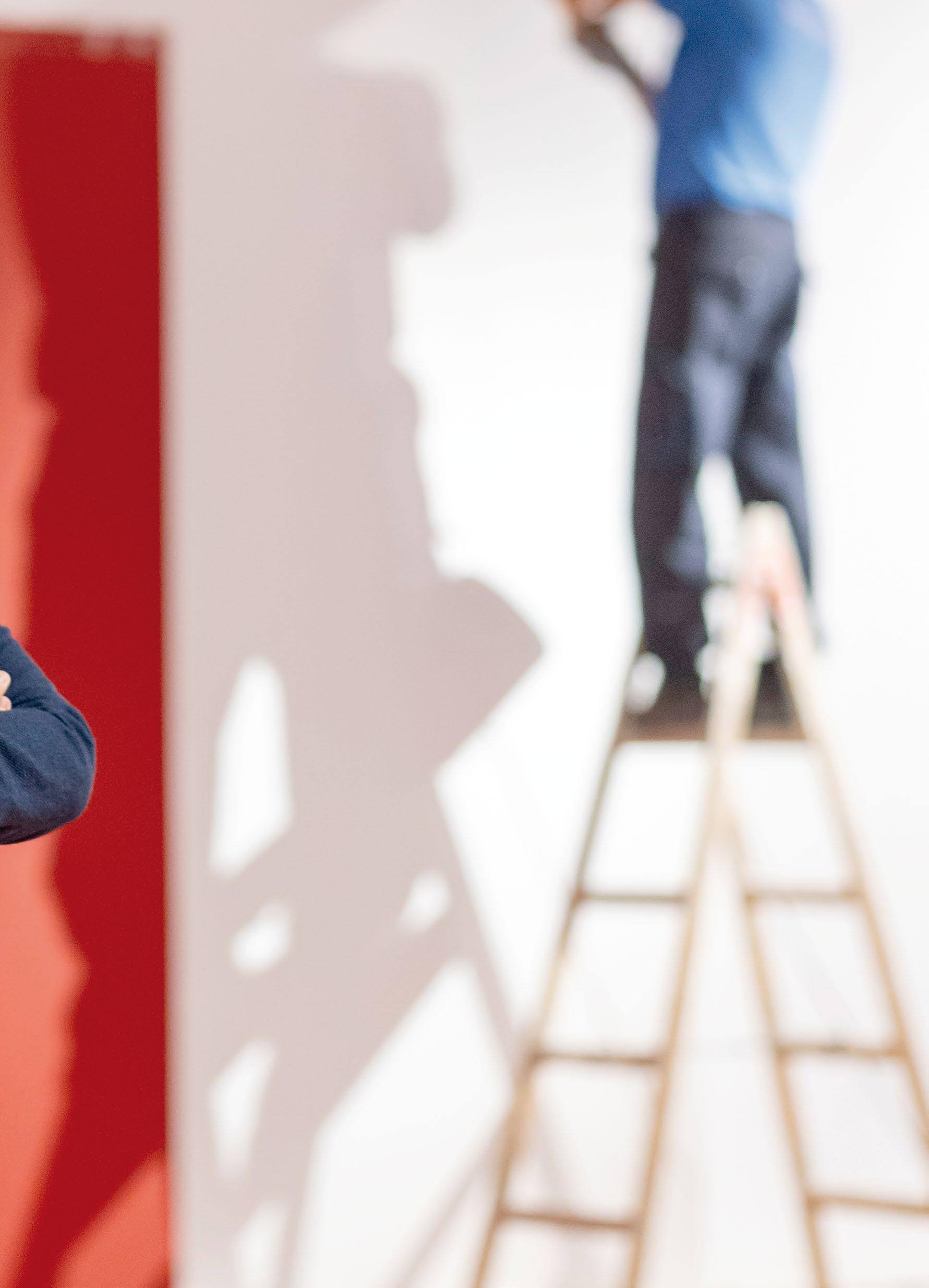

Carla Gannis, Selfi e Drawing 20, Leia, 2015.
Carla Gannis, Selfi e Drawing 20, Leia, 2015. Digital drawing, 30,5x30,5 cm. Courtesy: the artist.
1980 (Whip it, Devo),
1970 (Gravity’s Rainbow, Thomas Pynchon),
A track from the 80’s (Whip it, Devo), inspired by a novel from the 70’s (Gravity’s Rainbow, Thomas Pynchon), examines the collapse of a society that, stupefied by a delirium of overconsumption and information overload, worships the almost religious submission to technology — through which power is manifested, expanded, and normalized. And while these may have once seemed like strange signs of the times, nowadays we are discussing the consequences of this interaction and seeking ways to coexist, if not to reconsider our relationship with technology.
The exhibition “Technofetishism: Whip it into Shape”, hosted in MOMus-Experimental Center for the Arts (Warehouse B1, Pier A, Port) in Thessaloniki from March 21st until August 31st, 2025, explores the fetishization of technology by our contemporary techno-capitalist society, which has transformed technological objects into sources of sexual arousal, substitutes for desire, and venerated fetishes. The works presented offer a critical reflection on how technology mediates –and sometimes distorts– our notions of intimacy, eroticism, desire, and communication, our own identity, blurring the boundaries between freedom, compulsion, and constraint.
The exhibition highlights the emerging power and dependency relationships between ourselves and technological media, which have now become extensions of our bodies. These relationships are both evident and inextricably linked to consumption and control.
Curated by: Eirini Papakostantinou, art historian, curator at MOMus-Experimental Center for the Arts. n
WHERE & WHEN: At MOMus-Experimental Center for the Arts (Warehouse B1, Pier A) until August 31st, 2025. Before your visit, please check the MOMus website (www.momus.gr) for latest updates.
άνθρωπος και όλες οι
αναπαράστα-
του, σε κάθε πλαίσιο –οικογενειακό, κοινωνικό, επαγγελματικό, έμφυλο, μικροϊστορίας και μακροϊστορίας– μπαίνουν... στο κάδρο, στη φωτογραφική έκθεση με τίτλο «Περί ανθρώπων» του MOMus-Μουσείου Φωτογραφίας Θεσσαλονίκης. Η
παρουσιάζει μια ανθολογία 107 φωτογραφικών έργων, Ελλήνων και ελληνικής καταγωγής φωτογράφων, ιστορικών και σύγχρονων, από τις συλλογές
Humans and all aspects of their representation, in every context –familial, social, professional, gendered, microhistory as well as macrohistory– are put... into frames, at the photographic exhibition under the title “About Humans”, organised by MOMus-Thessaloniki Museum of Photography.
The exhibition presents an anthology of 107 works by Greek photographers or of Greek descendancy, historical and contemporary, from the Museum’s collections. From the dawn of the 20th century until today, the works outline, amongst others, staged portraits and nudes, the representation of the current or historical social and political condition, the snapshot activity with its natural spontaneity, the directorial invention with the fully controlled space.
They also incorporate unusual narratives, visual experimentations, journalistic idioms, metaphors on issues central for the human existence, such as death or the familiar versus the foreign, and the examination of self in the era of M culture. The exhibition closes with a note on tomorrow: the depiction of the post-human through special software and application of artificial intelligence.
Curated by: Hercules Papaioannou, curator at MOMus-Thessaloniki Museum of Photography. n

Viktor Koen, Call ball (Από τη σειρά Tasks & Games: Portraits of the Never Young, 1999). Φωτογκραβούρα. Συλλογές MOMus-Μουσείου Φωτογραφίας Θεσσαλονίκης. Viktor Koen, Call ball (From the series Tasks & Games: Portraits of the Never Young, 1999). Photogravure. MOMus-Thessaloniki Museum of Photography collections.
MOMus (www.momus.gr)
WHERE & WHEN: At MOMus-Thessaloniki Museum of Photography (Warehouse A, Pier A, Thessaloniki Port) until September 14th, 2025. Before your visit, please check the MOMus website (www.momus.gr) for latest updates.
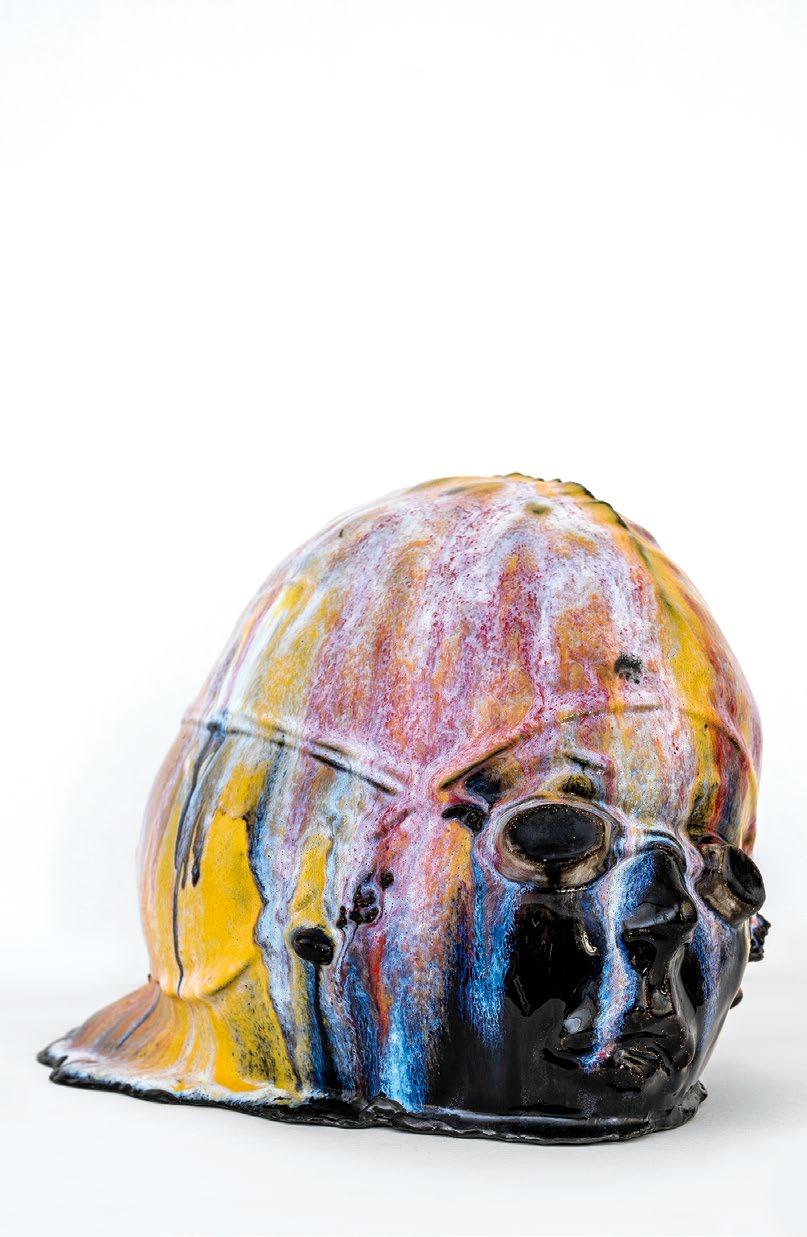
Δημήτρης
με υάλωση (stoneware), 34x25x30 εκ. Ευγενική
Dimitris Fragakis, Splats, 2024. Glazed ceramic (stoneware), 34x25x30 cm. Courtesy: the artist.

Μαριάννα
& Jason,
Christina Androulidaki Gallery. Marianna Ignataki, Jake & Jason, 2021. Watercolor, gouache, color pigments, graphite and colored pencils, 87x55 cm. Courtesy of CAN Christina Androulidaki Gallery.
Case Studio is the latest initiative of MOMus-Museum of Contemporary Art: an exhibition space dedicated to presenting the here-and-now of contemporary art. Its goal is showcasing both emerging and established artists, while fostering a closer connection between the museum and contemporary creative practices. Featuring solo exhibitions and projects by contemporary artists –primarily, though not exclusively–, by creators who are based in or originating from Thessaloniki alongside a variety of collective projects, Case Studio highlights alternative narratives and innovative models of knowledge production, promoting the values of social progress and empowerment.

Thessaloniki’s Airport “Makedonia” has been recognized in three important categories at this year’s 2024 Airport Service Quality (ASQ) Awards . Held in Spring and organized by the Airports Council International (ACI World), one of the most reputable organizations in the aviation industry, the airport earned the following distinctions based on passenger ratings alone:
• Best Airport of 5 to 15 Million Passengers in Europe (awarded consecutively over the last three years).
• Most Enjoyable Airport in Europe (first-time award).
• Cleanest Airport in Europe (awarded for the second consecutive year).
The ASQ awards follow a record-breaking year for Thessaloniki Airport “Makedonia”, which handled 7.38 million passengers in 2024, a 5% increase compared to 2023. Of these, 4.947 million were international arrivals (up 4.1%), while domestic arrivals reached 2.433 million (up 6.8%) The momentum continues in 2025, with 863,825 passengers recorded in January and February alone, reflecting an 8.8% increase over the same period in 2024.
Alexander Zinell , CEO of Fraport Greece , stated: “It is an honour to see Thessaloniki Airport ‘Makedonia’ recognized internationally again. These awards reflect the hard work and dedication of our team and all our partners, as well as our strategic commitment to continuously upgrading our services. The recognition by the passengers themselves is the greatest motivation for us to keep improving the travel experience in Thessaloniki.”
Fraport Greece continues to invest €50 million annually in upgrading and improving its 14 regional airports, with an additional €146 million dedicated to runway upgrades to meet the latest European Aviation Safety Agency standards. At Thessaloniki Airport “Makedonia”, the company has already introduced facility development , innovative technologies , and improved passenger services , ensuring a comfortable and pleasant travel experience for all travellers.
MOMus-Museum of Contemporary Art
March 27 - June 1, 2025
In this exhibition, Dimitris Fragakis’ paintings and sculptures of swimmers, portrayed on an unnatural and exaggerated scale elicit a grotesque, dark, and timeless atmosphere with their dominant and extreme deformations. Surreal images take center stage, alongside the artist’s other works.
Figures emerge and sink, float, or prepare to take the ultimate “dive”, not just into water but into the unchartered depths of existence. Here, confronting the unknown, the figures encounter both terror and ecstatic surprise.
Through his compositions, Fragakis confirms the purity of his art’s visual essence. Calling for deeper engagement, the artist intensifies his symbolic language, depicts his biological relationship with the world and explores existential and ontological questions. The great “dive” begins. A plunge into the world, into life, into the unknown.
Curated by Yannis Bolis, art historian & curator, MOMus.
MOMus-Museum of Contemporary Art
June 7 - August 31, 2025
Thessaloniki-born artist Marianna Ignataki’s career extends from Beijing to Berlin with works focusing on the human figure, or rather anthropomorphic forms. Initially a drawer and painter, Ignataki would then shift her focus on sculptures and installations that awaken a dreamlike, nightmarish, ironic, and often deliberately kitsch subconscious. Identity is central in Ignataki’s art, as is the surreal, almost theatrical quality of her images. Vibrant drawings contrast with her monochrome sculptures.
The characters inhabiting her work exist in a timeless space, as they search for selfhood, freedom, and the contexts that define their survival, be it sexual, moral, or existential. Some may succeed in their quest, others may not. Beyond the artist’s vision, her characters offer an alternative form of personal revolution and resistance.
Curated by Thodoris Markoglou, art historian & curator, MOMus-Museum of Contemporary Art. n
WHERE & WHEN: At MOMus-Museum of Contemporary Art (154 Egnatia Av., in the TIF-Helexpo premises, Thessaloniki).
Before your visit, please check the MOMus website (www.momus.gr) for latest updates.
Having served as Minister of Culture for six years, Lina Mendoni has an extensive track record of accomplishments. More importantly, plans under her remit align with a vision for the future, where Culture as a public and social asset is intrinsically linked to development and equally accessible to all, regardless of social status, income, or education level.
Madam Minister, in a country like Greece, with all its archaeological sites and monuments, how challenging is it to turn people’s attention to contemporary art?
This question concerns our self-perception of modern Hellenism, defined by two-centuries of freedom and sovereign statehood. Throughout this time, we’ve often been tormented with comparisons to our ancestors, first as inheritors of an extraordinary cultural imprint, and second as seekers of the most appropriate ways to manage its immense weight.
I think today we no longer feel confined by it, but to the contrary hold pride in our centuries-old heritage. The goal however is not to prove ourselves as worthy successors, but
to draw meaningful inspiration from this inexhaustible reserve, which has the potential to evolve into contemporary art of the highest level.
Our modern civilization isn’t overshadowed by our past or everything we’ve inherited from it. Instead, it coexists, co-operates and draws from its inexhaustible reserve. Therefore, displaying our monumental heritage aims not only at the obvious, i.e. our ability to feel, preserve and promote, but to see it evolve as a fertile catalyst and source for contemporary art.
Do you think Thessaloniki, especially with the completion of the metro museums, has the potential to become the cultural capital of the Balkans? Is that a possibility?
The metro’s handover and operation have profoundly transformed daily life for residents and its visitors’ experience. Equally, it features the largest internationally integrated archaeological site within a major infrastructure project, along with two museums that will house the excavation findings. The metro is the kind of infrastructure that has a multiplier effect on the city and it aligns with the richest monumental reserve of Thessaloniki, that is its iconic museums and key contemporary art organizations.
In other words, Thessaloniki, which is the metropolis of its wider region, already has a coveted cultural heritage and a modern cultural and intellectual movement, which the metro – both as the infrastructure and installation hosting the antiquities – comes to highlight.
The Ministry’s mission is fully dedicated to support Culture, in all its manifestations across the city. Today, it is up to civil society, the people of the city – as well as every city – to give life to projects and actions the Ministry promotes. Thessaloniki has what it takes to become a cultural metropolis of the Balkans, with its already strong footprint on the wider neighbourhood. But this primarily lies with its own people.
What are your plans for strengthening cultural production in Thessaloniki and Macedonia?
Allow me to give you a sense of scale. In recent years, we have been delivering a program of projects and initiatives in Thessaloniki and Central Macedonia with a total investment exceeding 150 million euros. Projects totalling 65 million euros from the Recovery Fund are currently underway, primarily supporting major interventions in Thessaloniki. For example, projects are in progress across the city’s extensive collection of Byzantine monuments and Ottoman-era buildings. Steady progress is being made on the two museums that will showcase the antiquities unearthed during the metro construction excavations. Furthermore, restoration work is also underway on the historic building of the State Conservatory.
I would also like to highlight that a total of 31 million euros from the National Strategic Reference Framework (NSRF) and the Recovery Fund has been allocated to upgrading infrastructure and advancing the digital transformation of the Ministry of Culture’s supervised entities in Thessaloniki. There is a coherent plan in place that concerns both the cultural heritage in Thessaloniki –colossal in scope and depth– and contemporary art. These must both function together and feed off each other.
The Polycentric Museum of Aigai, inaugurated in 2022, harmoniously combines modern technological means with the exhibits. How do you think technology is changing museums? What role do museums play today?
Correct. The Polycentric Museum of Aigai is a model that harmoniously couples cultural heritage of a universal caliber with the most advanced technology. Technology has
Δημοσίων Επενδύσεων
και, ασφαλώς, τα ευρωπαϊκά χρηματοδοτικά εργαλεία, κυρίως το Ταμείο Ανάκαμψης και το ΕΣΠΑ. Προφανέστατα, τα έργα
και οι δράσεις μεγάλης κλίμακας ενέχουν ισχυρότατη κοινωνικοοικονομική δυναμική, καθώς καλλιεργούν οικοσυστήματα επιχειρηματικότητας,
a decisive impact on museums and cultural heritage. It gives us new methods to conserve, restore, document and promote precious artifacts, ensuring that part remains remembered. It provides us, as you mentioned, with new tools to showcase exhibits. The digital management of a museum’s physical object, that is, its collections, allows people from all over the world to admire them. This was extremely important during the pandemic, when museums were subject to restrictions and were, in effect, closed.
I note that, in museums, the use of advanced tools is priceless and non-replaceable for people that are vision or hearing impaired.

However, the possibilities for displaying and highlighting collections through digital tools must be aligned with museological principles and objectives, so as not to disrupt the public’s direct engagement or experience with the physical object of museums, i.e. their exhibits.
Of the 575 million allocated in the 2025 budget, how much is earmarked for the promotion of cultural entrepreneurship? What are the Ministry’s actions and policies to support its development?
Turning the question around, I would say that every last euro directly or indirectly supports cultural entrepreneurship. The amount you mention includes funds coming from different sources, such as the Μinistry’s standard budget, the Public Investment Program and, of course, European financial instruments, mainly the Recovery Fund and the NSRF. Certainly, large-scale projects and actions carry strong socio-economic dynamics, and they cultivate entrepreneurship ecosystems, create primary and secondary employment and elevate Culture as a holistic development tool, which can – and must, this is our goal – have a catalytic effect on the economic development of entire regions. But even the ordinary work carried out by a local Ephorate of Antiquities, for example, has an invisible economic footprint, as it can potentially –and I say “potentially” because it is up to local communities to derive the maximum benefits from it– upgrade the region, make it a pole of attraction, stimulate existing economic activities and encourage new ones.
Hence, it is not just a matter of capital. It is also –mainly– a matter of mindset and perception of Culture as a development lever. If this is not embedded, no matter how many financial resources we direct toward it, it will yield poor results.
How satisfied are you today with the security of archaeological sites, and their opening hours? Is there room for improvement, especially in places with increased visitor numbers?
The number of visitors to archaeological sites is
constantly increasing, which, of course, creates new needs for staff. As for security –including the physical protection of the sites and exhibits– the level is high, and this is demonstrated by the management of millions of visitors without the slightest damage or loss. It is a demanding task.
At the Ministry of Culture, we closely, and in detail, monitor movement in monuments and museums, which helps when needing to make changes to opening hours and the number of employees responsible for welcoming visitors. For example, the Acropolis has different needs to a smaller archaeological site and that’s completely natural. Hence, staff allocations must be adapted.
I would like to say that, in addition to the security guards, the Ministry implements – and, in fact, with great impact and success – policies that relieve pressure on staff. The establishment of visitor zones at the Acropolis and the widespread availability of electronic tickets to over 100 museums and archaeological sites not only streamlines staffing needs but also makes access and management of larger flows of visitors much easier.
The phenomenon of large fires has threatened (or even destroyed) monuments and archaeological sites several times – for example, the buildings of the Tatoi estate. How well prepared are we to deal with such situations? And, also, do you have any idea when the buildings of the Tatoi estate will reopen?
The enormity of the fires has threatened both monuments and archaeological sites. However, in the last six years, it has never destroyed any of them, even when the flames got close. I do not say this as a consolation. The fact that the monuments were saved in the Tatoi estate, which you mentioned, while having suffered large scale forest losses, does not satisfy us. On the contrary, it motivates us to take even more intense measures. The Ministry of Culture is consistently preparing and conducting studies on the fire protection of archaeological sites, considering not only their special characteristics, but also the fluctuations and changes within the threat itself. This is a demanding and ongoing fight against an enemy that, aided by climate change, takes on new shapes and forms.
As for the greater-area cultural and recreational center of the former royal estate in Tatoi, the works are at a very advanced stage. This year marks a major milestone, with the completion of the core museum infrastructure, set to open to the public by year’s end. The restoration of the Gardens is also expected to be completed within the same timeframe. Additionally, plans for restoring the Adjutancy, which will house essential support functions for the estate and the former swine enclosure, which will be repurposed as a shop, have been approved.
Last year there were various reports about the repatriation of the Parthenon Sculptures. How likely is such a scenario? Is it still on the table?
If repatriation of the Sculptures were not on the table, we would have ended discussions with the British Museum. The reunification of Phidias’ masterpieces with their natural host, the Parthenon, is a national goal with a universal dimension. Discussions with the British side are ongoing, and it is fully expected that they will lead to publications. I am obliged to reiterate that we do not recognize any form of legal ownership or possession of the Sculptures by the British Museum – this is an inviolable national stance. However, negotiations require extremely delicate and careful handling and for this reason, it’s not suitable for predictions.
I also have two personal questions. After six years in the Μinistry, what do you consider to be your most important accomplishments to date? Can you choose?
Truth be told, it’s difficult to choose. I don’t want to do injustice to any of the projects I have promoted. Not only because I have devoted time and effort to many and extremely diverse projects and actions, but also because I have never ranked them on any scale of importance. You know, even the smallest project in Culture is by definition important and, above all, can have a very significant impact, the scope of which can be predicted.
There are, of course, the iconic projects, which absorb gigantic human and material resources and concern monuments of global renown, poles of attraction for hundreds of thousands of people, or extremely complex projects, which have never been undertaken before and require innovative approaches or knowhow. The Tatoi estate you mentioned earlier is among them.
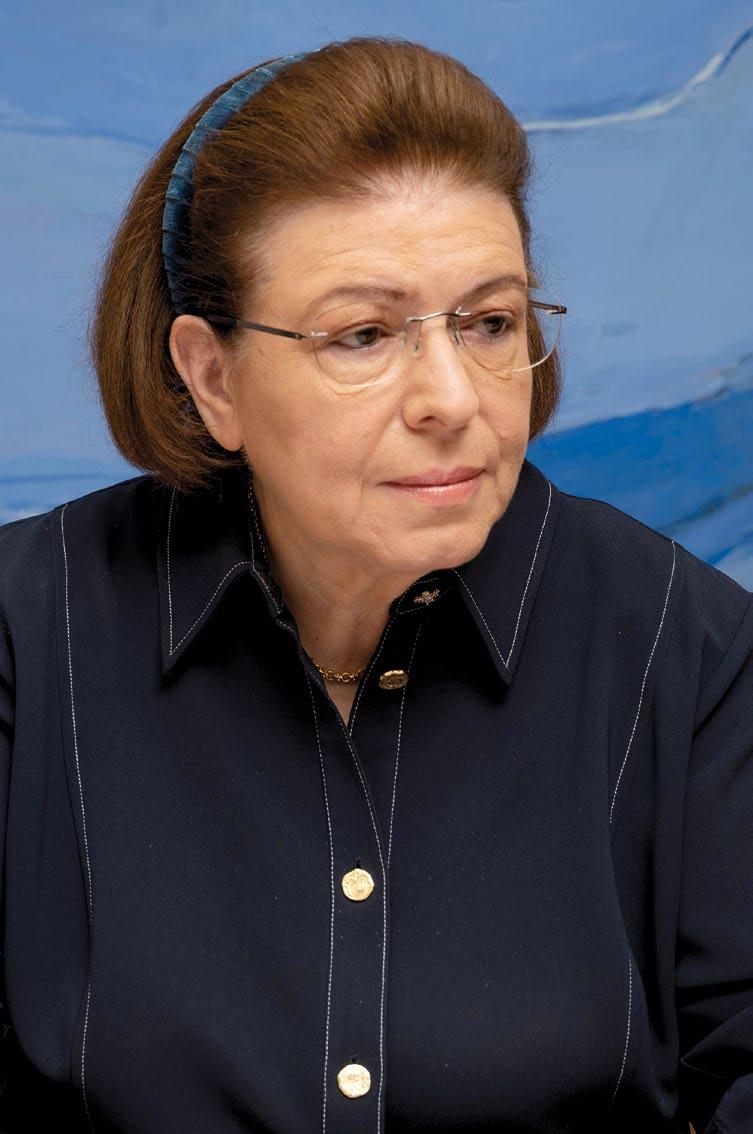
If I had to choose, without any inclination to prioritize, it would perhaps be the systematic and unwavering effort we have undertaken for complete accessibility to every monument, museum and cultural space for everyone and everywhere. A laborious, methodical and by its nature long-term effort to make every cultural structure accessible to each and every one and, above all, to people with disabilities. This touches the core of the social bond, Democracy itself, as it concerns the equal enjoyment of rights. I note with satisfaction that it is an effort that has already borne fruit and continues unabated and unwavering.
And the second personal question: I would like you to share with us your vision for the cultural charter of Greece. After the end of your second term, how would you like to see the landscape?
I’m happy to hear the term “charter”, because at the Ministry of Culture we have compiled for each of the thirteen Regions of the country the Cultural Charter for Development and Prosperity, with infrastructure projects interconnected with actions that strengthen contemporary art and grow cultural tourism, but also with the necessary institutional reforms. It clearly reflects our strategy for Culture, which Prime Minister Kyriakos Mitsotakis has elevated to a strategic development resource and an important factor of social cohesion and prosperity.
My vision and my plan –there is no vision without a plan in execution– is a Culture that is spatially and socially extended. A Culture-Public social asset, directly intertwined with development. A Culture that is a matrix of employment and a source of national wealth, that does not develop in sterile conditions but communicates directly with economic reality and its social environment and as mentioned, is equally accessible to all, regardless of social status, income or educational level. n

A true art explorer with a keen eye for detail, Thessaloniki-based Evi Papavergou has been curating MOMus’ educational programs for 20 years. Yet she still longs for her native Kavala, the city she grew up in.
My journey with MOMus began in 2005, when I interned at what was then the State Museum of Contemporary Art. After completing a postgraduate degree in England, I returned to Greece and rejoined the Museum, this time as an external collaborator. In the early days, before the Education Department had fully taken shape, I’d visit secondary schools to present Biennale Goes to School. Soon after, alongside Katerina Paraskeva, we developed the Museum’s educational programs at the former Center for Contemporary Art, in the port area, before settling into the Lazaristes Monastery.
One of my fondest memories from those early years was my very first day as an intern. At the time, the Center for Contemporary Art was hosting an exhibition on the Russian AvantGarde on moving images. I remember everyone was hard at work setting up the exhibition and my very first task was to paint a wall. Though seemingly trivial, tasks like setting up, painting, hammering, labelling, and adjusting the lighting became my first real lessons on the job. It was this collective physical effort of installation and completion that resonated with me immediately. Then, while unpacking artworks, I found myself face-to-face with reconstructions of Klutsis’s propaganda pavilions, Eisenstein’s storyboards, and the film Aelita. In that moment, I knew this is the world I wanted to be part of.
To live among these works, to continuously learn from them, to be surprised by them is a privilege. In the nearly 20 years I’ve worked with the Costakis Collection, my favorite piece is never the same. Dynamic City by Klutsis, Red Light by Kliun, Spatial Force Construction and Dramatic Architecture by Popova are among those that have really marked me over time. Lately, however, I’ve been especially impressed by Man and Cloud by Solomon Nikritin. Created in the late 1920s, the work reflects a time when artists were forced to shift toward representation, as experimentation and formalism were increasingly persecuted, along with many artists themselves, deemed enemies of the Stalinist regime.
Looking back, I realize I’ve always had this urgent need to mix things up. Since childhood, I’ve been alternating between practice and theory: creative work and the theoretical element of art. That ability to move between making and researching, creating with my hands and immersing myself in the intellectual world of an art movement or a new pedagogical approach; it’s this balance that has always been essential to me. It’s what ultimately led me to museum education.
Designing an educational program for an exhibition requires thorough research to discover the essence behind the artworks. Academic texts and bibliographies often contain hidden threads of meaning, facts, or ideas that we, as museum educators, reinterpret in our role as mediators between the artwork and the visitor. Once I’ve analyzed the most essential elements I want to highlight, I then imagine ways to make them accessible, engaging, and above all fun. The goal is to inspire self-directed exploration.
If the children find something of themselves in the Museum, whether in a specific artwork, through play, or in the life of an artist then I know I’ve done something right. The future visitor will return, seeking inspiration, new ideas, or even solace and inevitably cultivate their own relationship with the Museum. Just as I once did. n
“If the CHILDREN find something of themselves in the MUSEUM, then I know I’ve done something RIGHT.”
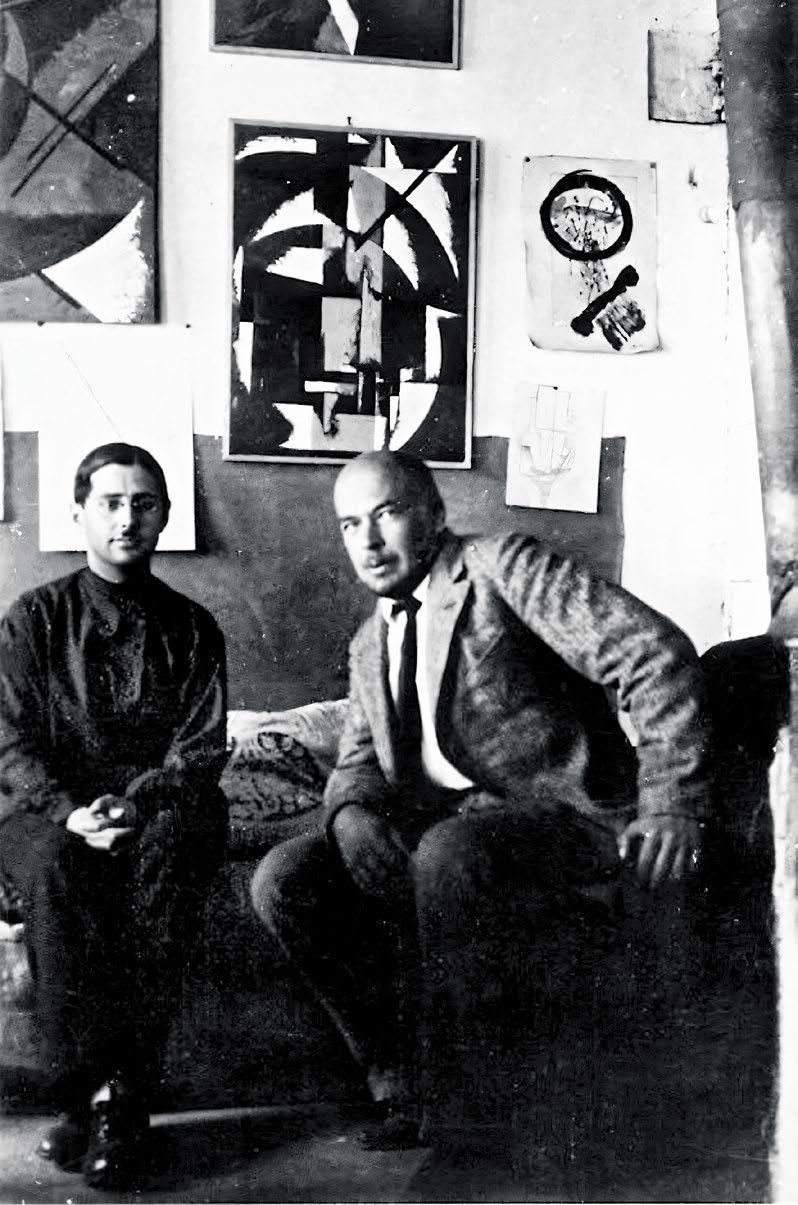
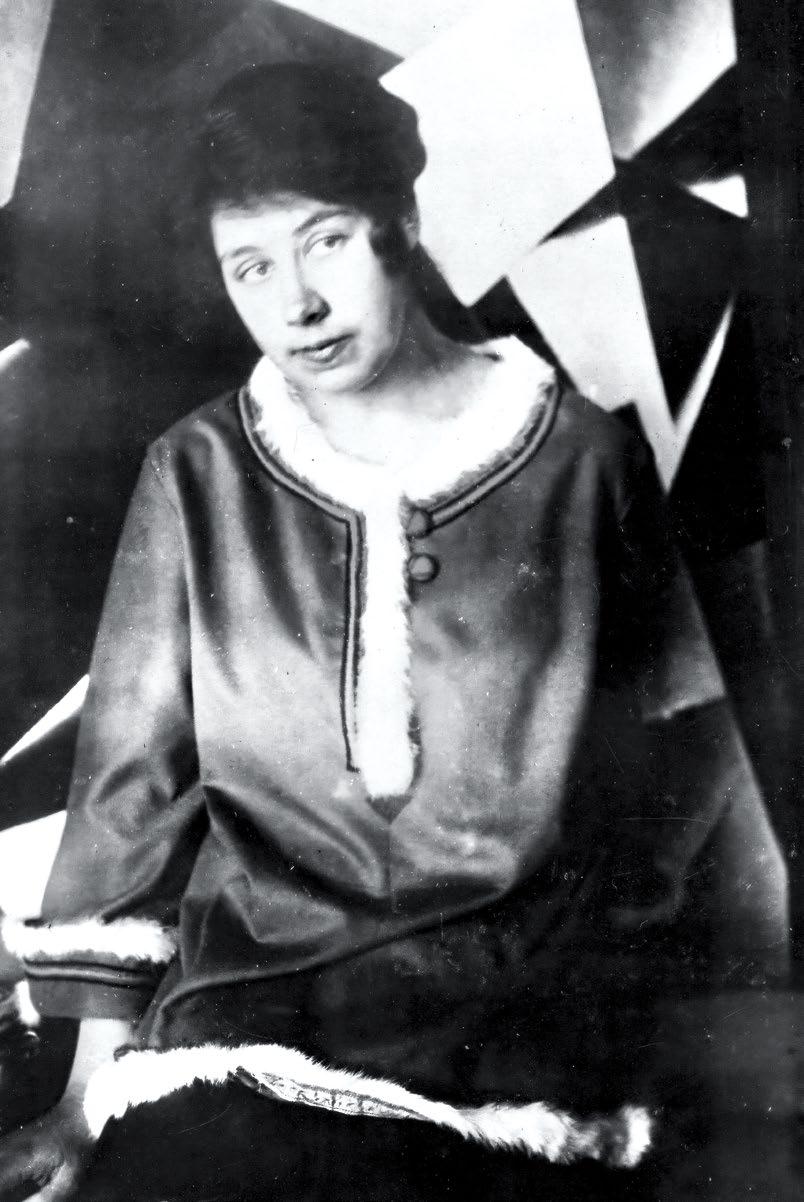

Επάνω αριστερά: ο κονστρουκτιβιστής αρχιτέκτονας Αλεξάντρ Βεσνίν με τον αδελφό της Λιουμπόβ Ποπόβα, Πάβελ, στο στούντιο της καλλιτέχνιδας μετά τον θάνατό της (1924). On the top, left: Constructivist architect Aleksandr Vesnin with Liubov Popova’s brother, Pavel, in Popova’s studio after her death (1924).
Επάνω δεξιά: η Λιουμπόβ Ποπόβα στο στούντιό της, αρχές 1919. MOMus-Μουσείο Μοντέρνας Τέχνης-Αρχείο Κωστάκη. On the top, right: Liubov Popova in her studio, early 1919. MOMus-Museum of Modern Art-Costakis Archive.
Αριστερά: Λιουμπόβ Ποπόβα,
1921. Λάδι
On the left: Liubov Popova, Space Force Construction, 1921. Oil and mixed technique (paint and wood shavings) on plywood, 112,3x112,5 cm. MOMus -Museum of Modern Art-Costakis Collection.
How did a painting by Lyubov Popova end up in a rural warehouse outside Moscow?
KEIMENO/ΤΕΧΤ
Papadimitriou
Each of the 1,275 works in the Costakis Collection, housed at MOMus-Museum of Modern Art, carries its own story. Some are well-documented, others remain a mystery, and some may never be revealed. Together, these stories make up the collection’s legend with its many myths surrounding the collector, George Costakis.
Many of these myths originated from the way Costakis acquired the works. As a Greek citizen working at the Canadian embassy, his movements within the Soviet Union were restricted. Resolving this, he’d often sent his wife and daughter, both Soviet citizens, to purchase artworks. At times, however, all three travelled together in pursuit of rare pieces.
One of the most remarkable discoveries during these family trips were paintings by Lyubov Popova, a key protagonist of the Russian Avant-Garde. Popova’s brother, Pavel Sergeyevich, had informed Costakis that some of her works might still exist in a country house in the suburbs of Moscow, where his stepson lived. Taking up the offer, Costakis and his family visited the house and discovered what could only be described as an “art repository.”
As he later recounted in his memoirs, “the first thing I saw as I went up to the second floor was a painting by Popova with a tub hanging over it.” But the greatest surprise awaited them in the expansive garden, filled with sour cherry trees and white-pink apples. There, they found a warehouse with a window covered by a piece of plywood. On the wood, Costakis noticed a number and, beneath it, Popova’s signature. Inside the warehouse, he found Spatial Force Construction, a striking 1921 oil painting mixed with wood shavings.
To acquire the piece, Costakis had to return to Moscow in search of plywood, as the landlord had been using the painting to shield the window from rain. In the end, he exchanged two sheets of plywood for the single painting and purchased the rest at a remarkably low price.
This is yet another one of those extraordinary “miracles” that preserved Russian Avant-Garde works, pieces that might otherwise have met the same fate as countless others, destroyed even within museums during the Soviet battle against “formalism.” n
The unexpected, the ambiguous and the enigmatic, the imaginary and the grotesque act as a conceptual and spatial grid for the exhibition “a Cabinet of Curiosities” presented at MOMus-Museum Alex Mylona. The same things seem to inspire one of the most charismatic designers of our times.
School Projects,
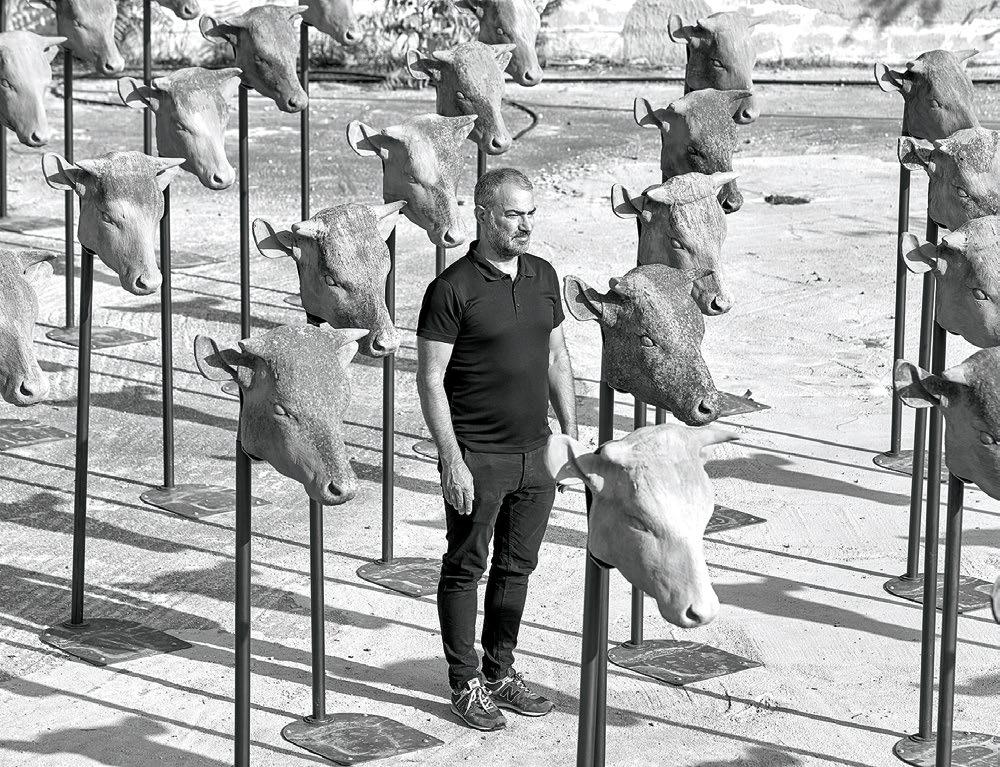
Dionisis Christofilogiannis’ work engages with the traces of mythology, memory, and tradition on contemporary society. Working across a diverse range of media –including painting, installations, photographic collages, and sculpture–, his practice focuses on architecture, geometric abstraction, and classical forms, examining how they intersect with lyricism and produce sociopolitical commentary.
Christofilogiannis participated in the CITYX Venice Italian Virtual Pavilion of the 17th Venice Architecture Biennale with MOMAFAD (Museum of Modern Art for a Day), which he founded. This civic intervention transformed the former Hellinikon International Airport in Athens into a temporary museum, interrogating the socio-political significance of space and architecture. The project was presented at the National Museum of Contemporary Art – EMST, in Athens.
Recently, he had the privilege of presenting “The Army of Goumas” at the Eleusis, European Capital of Culture event. This piece delves into themes of cultural heritage and collective memory, using sculptural forms to explore historical narratives and their contemporary relevance. One of Christofilogiannis’ key series, “Feels Like Home,” juxtaposes images of familiar urban landscapes in Athens and Thessaloniki with apocalyptic scenes from Syria presented in Thessaloniki Biennale 6. This series challenges viewers to confront the fragility of their perceived safety and stability, emphasizing the precarious nature of what we consider ‘home.’ He is also the founder of space52, an artist-run space in the heart of Athens dedicated to exhibitions, publications, and residency programs.
Nakagawa Gallery Tokyo,
Kunsthalle Athens

His exhibition history includes international institutions such as National Museum of Contemporary Art Greece – EMST, MOMus Thessaloniki, the Contemporary Museum of Naples, the Ibero-American Museum of Contemporary Art (MEIAC), the Muzeul de Artă Cluj-Napoca, Nakagawa Gallery Tokyo, Hydra School Projects, Kunsthalle Athens, and the Benaki Museum. n

«a Cabinet of Curiosities»,
MOMus-Μουσείο
Dionisis Christofilogiannis, “Thero’s Temple”, 2024. Plexiglass, wood, 24 carat gold leaf, gold spray, black sand of Anafi, 25x35x25 cm. Courtesy: the artist. The work will be part of the exhibition entitled “a Cabinet of Curiosities” presented at MOMus-Museum Alex Mylona until August 31st, 2025.


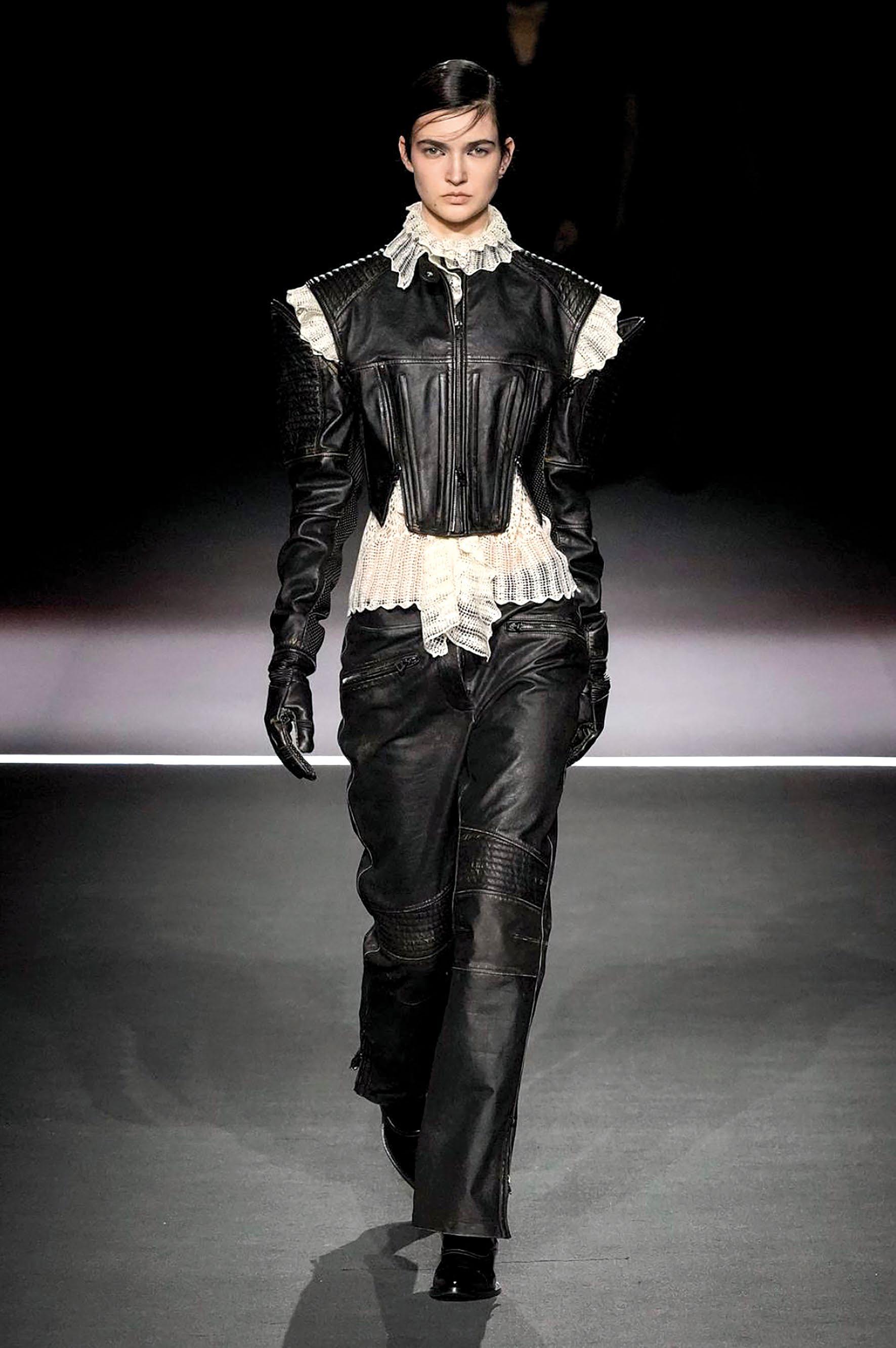
Ready-to-Wear,
2025-2026. Maria Grazia Chiuri for Dior, Ready-to-Wear Collection, Autumn-Winter 2025-2026.

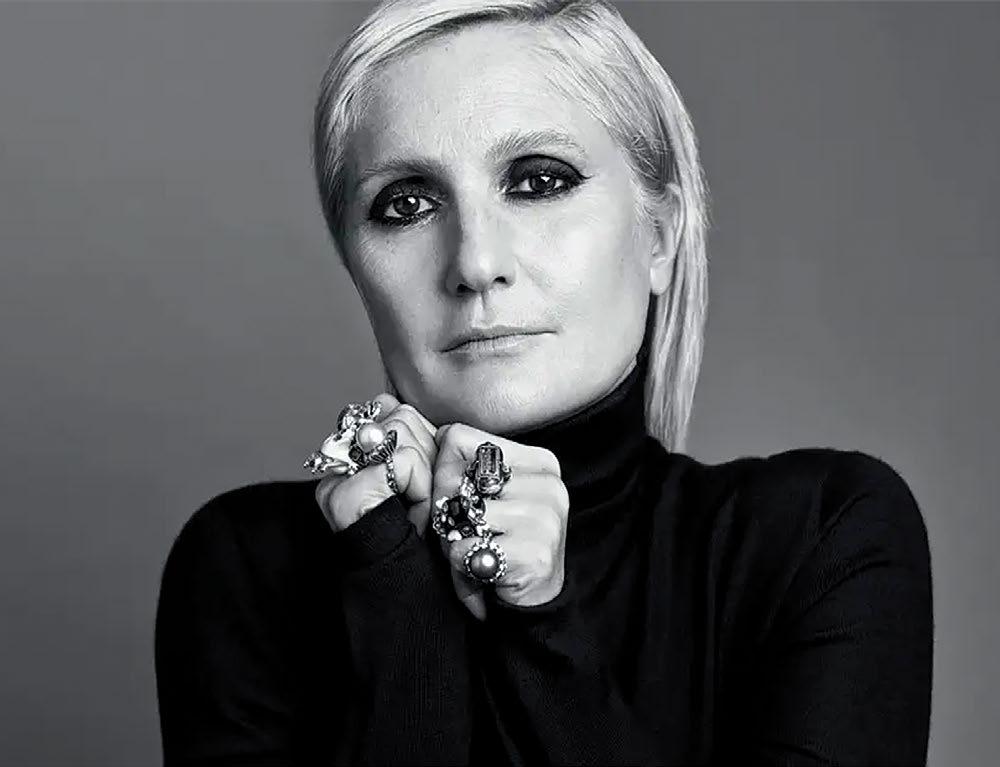
Maria Grazia Chiuri has been at the helm of Dior since 2016, making waves as the house’s first female creative director. Her move to Dior marked a significant shift, not just for the brand, but for the industry as a whole. Prior to this, Chiuri spent 17 transformative years at Valentino, where she and Pierpaolo Piccioli revamped the brand’s image, turning it back into a powerhouse. Together, they spearheaded Valentino’s ascent, breathing life into everything from menswear to accessories, including the iconic Rockstud. Their work earned them the CFDA International Award in 2015.
At Dior, Chiuri has used her platform to emphasize femininity with a sharp edge—her message is as much about the clothes as it is about the dialogue they create. Her debut in 2016 featured the slogan tee declaring, “We Should All Be Feminists,” inspired by Nigerian writer Chimamanda Ngozi Adichie. She also reintroduced the Saddle bag, making it a modern musthave through savvy influencer marketing, bringing Dior into the social media age.
Chiuri’s collections often engage with cultural moments—whether through tributes to art historian Linda Nochlin or collaborations with global artisans, such as the embroidery workshops for Dior’s Cruise 2024 collection. In July 2019, her impact was recognized with the Légion d’honneur, France’s highest honor, acknowledging her influence both inside and outside the ateliers.
Chiuri’s reign at Dior balances the brand’s storied past with a modern urgency that makes her designs more than just runway pieces. They are statements, conversations, and reflections of the world, challenging the fashion industry to embrace change. n

«Paradise is the new Hell» (2016).
If you could invite a famous artist to dinner, with a top chef preparing the menu, who would you choose? And what would you serve? In this issue, MOMus “invites” artist Filippos Tsitsopoulos (1967) to dinner, drawing inspiration from his artwork “Paradise is the new Hell” (2016), and taps into the creative imagination of Gikas Xenakis, executive chef of “Aleria” restaurant, in Athens, to prepare the menu.
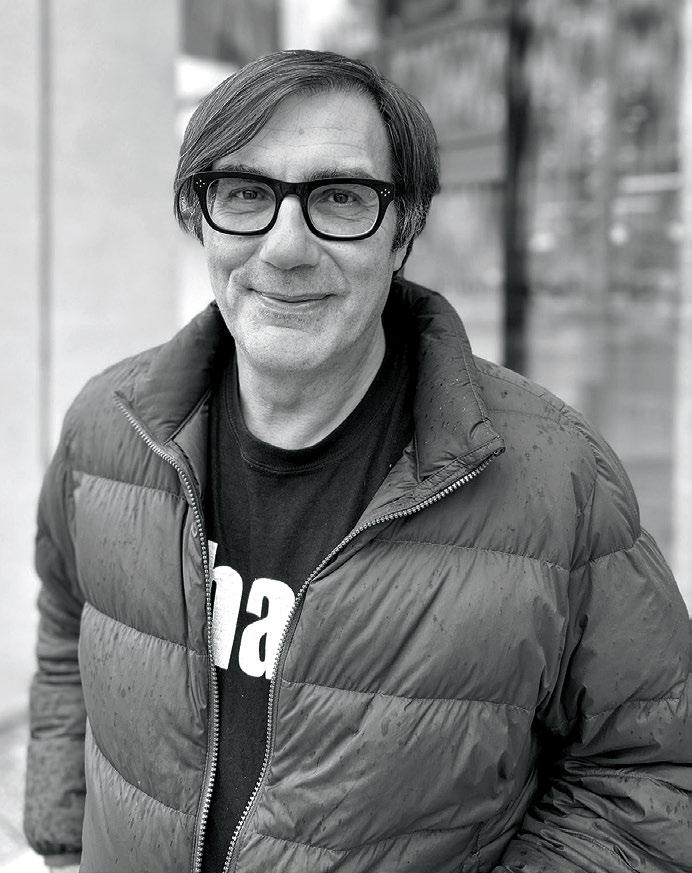
Ο
Φίλιππος Τσιτσόπουλος (1967)
είναι ένας πολυσχιδής καλλιτέ-
χνης που δραστηριοποιείται στη
ζωγραφική, τις εγκαταστάσεις, τα μέσα και την περφόρμανς,
διερευνώντας τη σχέση μεταξύ
θεάτρου και εικαστικών τεχνών
από τη δεκαετία του 1990. Απόφοιτος της Σχολής Καλών Τεχνών του ΑΠΘ και διδάκτορας του Πανεπιστημίου της Μαδρίτης, έχει ζήσει και δημιουργήσει
Philippos Tsitsopoulos (b. 1967) is a multidisciplinary artist whose work —paintings, installations, media, and performance— has explored the dynamic relationship between theatre and the visual arts since the 1990s. A graduate of the School of Fine Arts at Aristotle University of Thessaloniki and a PhD recipient from the University of Madrid, he’s lived and worked in Spain, Liverpool, and currently London. His video installations and performances are presented internationally, and merge theatrical elements with visual art, like masks made from living or organic materials. During his performances for instance, he recites theatrical passages while wearing imaginative masks made from fruits, vegetables, fish, shells, and other natural materials. The artist’s work unites painting, theatre, and performance, inviting audiences into an immersive and interactive artistic experience. n
To
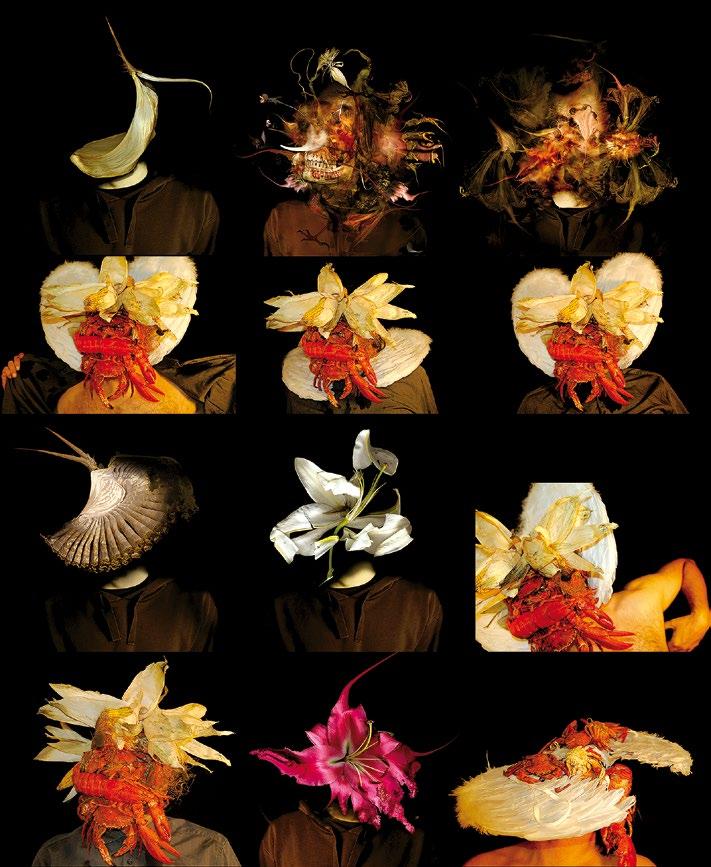
Courtesy: the artist
What would chef Gikas Xenakis make for Filippos Tsitsopoulos?
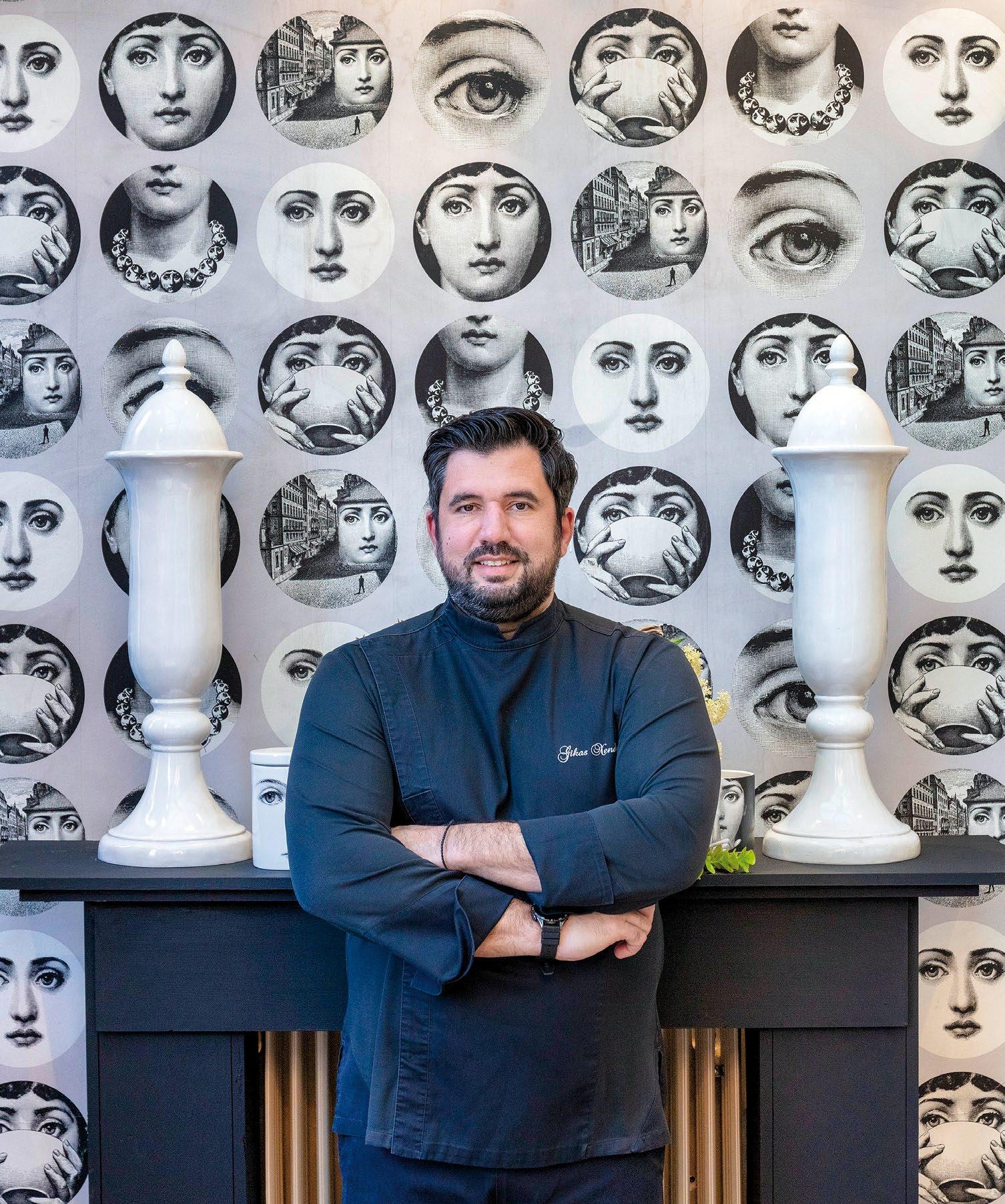

For the lamb:
2 lamb shoulders (about 2.5 kg)
85 g salt
25 g sugar
2 sprigs thyme
800 g water
For the eggplants:
3 white eggplants
200 g salt
100 g tahini
100 g raisins
20 g Jerez vinegar
Salt
For the yogurt sauce:
400 g chicken broth
80 g yogurt
15 g tandoori
10 g dehydrated yogurt
5 g lecithin
Salt
For the cumin-infused
rich lamb broth:
1 liter rich lamb broth
200 g red wine
2 tbsp Jerez vinegar
1 sprig thyme
A knob of butter

φόρμα με βάρος από πάνω. Παγώνουμε στο ψυγείο. Όταν παγώσει, το σοτάρουμε σε καυτό τηγάνι με ελαιόλαδο.
Για τις μελιτζάνες: κόβουμε τις
λευκές μελιτζάνες στη μέση και
κατά μήκος. Παστώνουμε με το
αλάτι για 20 λεπτά. Έπειτα αφαιρούμε το αλάτι και τηγανίζουμε
στους 150 βαθμούς, μέχρι να μαλακώσει. Στραγγίζουμε από το
λάδι. Σε ένα μπλέντερ βάζουμε τις σταφίδες, το ταχίνι, ελάχιστο νερό και το ξύδι. Χτυπάμε
πολύ καλά και περνάμε από σίτα. Αλείφουμε
Lamb: season the lamb with salt, water, and sugar and leave overnight. The following day, drain and slow-roast the lamb in a roner at 80°C for 12 hours. Once cooked, pull off the meat, place in a round container, cover and chill. When chilled, sauté in a hot pan with olive oil until golden.
Eggplants: slice the white eggplants in half lengthwise and sprinkle with salt. Let them sit for 20 minutes, then rinse off the salt. Fry at 150°C until tender, then drain excess oil. In a blender, combine raisins, tahini, a splash of water, and vinegar, blending until smooth. Sift the mixture, spread it over the eggplants, and bake for 2 minutes.
Yogurt sauce: combine all the ingredients, except for the lecithin, in a saucepan. Heat gently and sieve the mixture. Next, add the lecithin to the sauce and whisk until frothy.
Cumin-infused rich lamb broth: reduce the wine in a saucepan, then add the rich lamb broth and bring to a boil. Finish with butter and Jerez vinegar. n
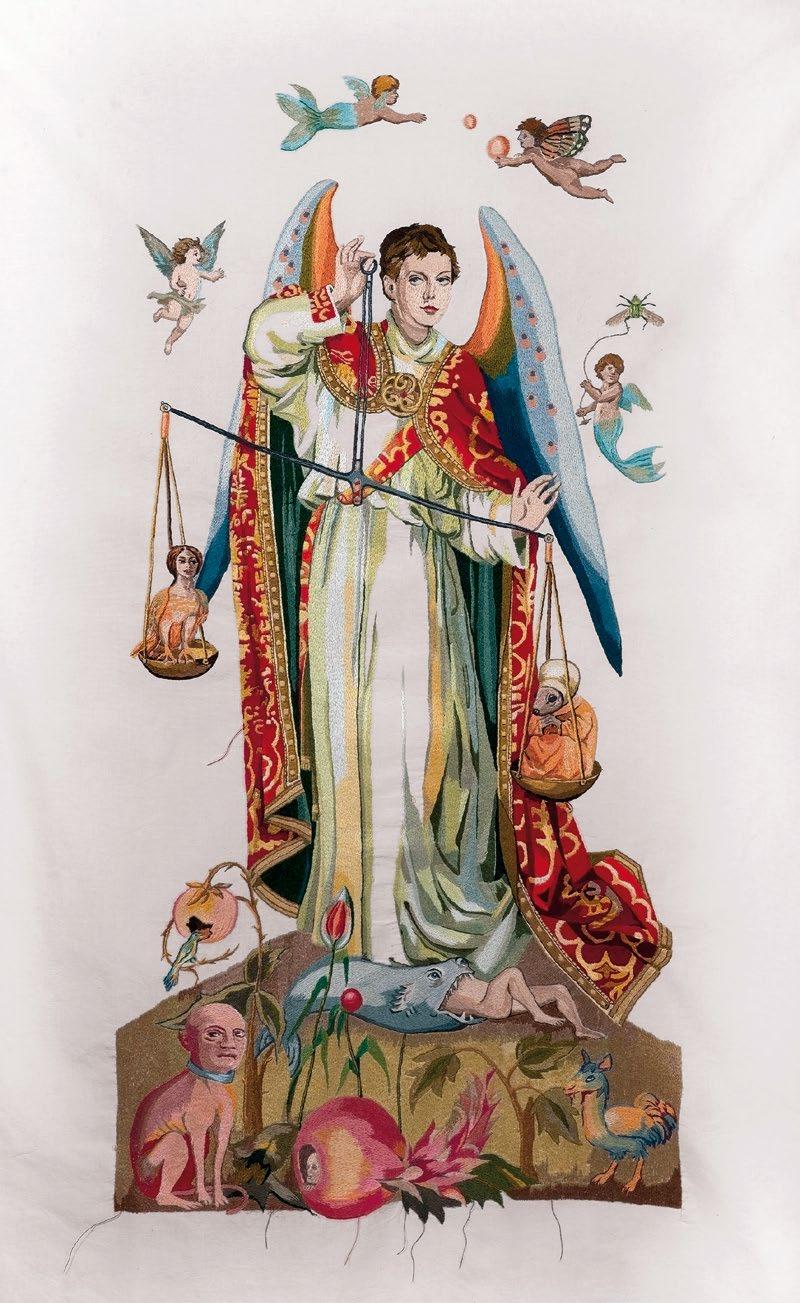

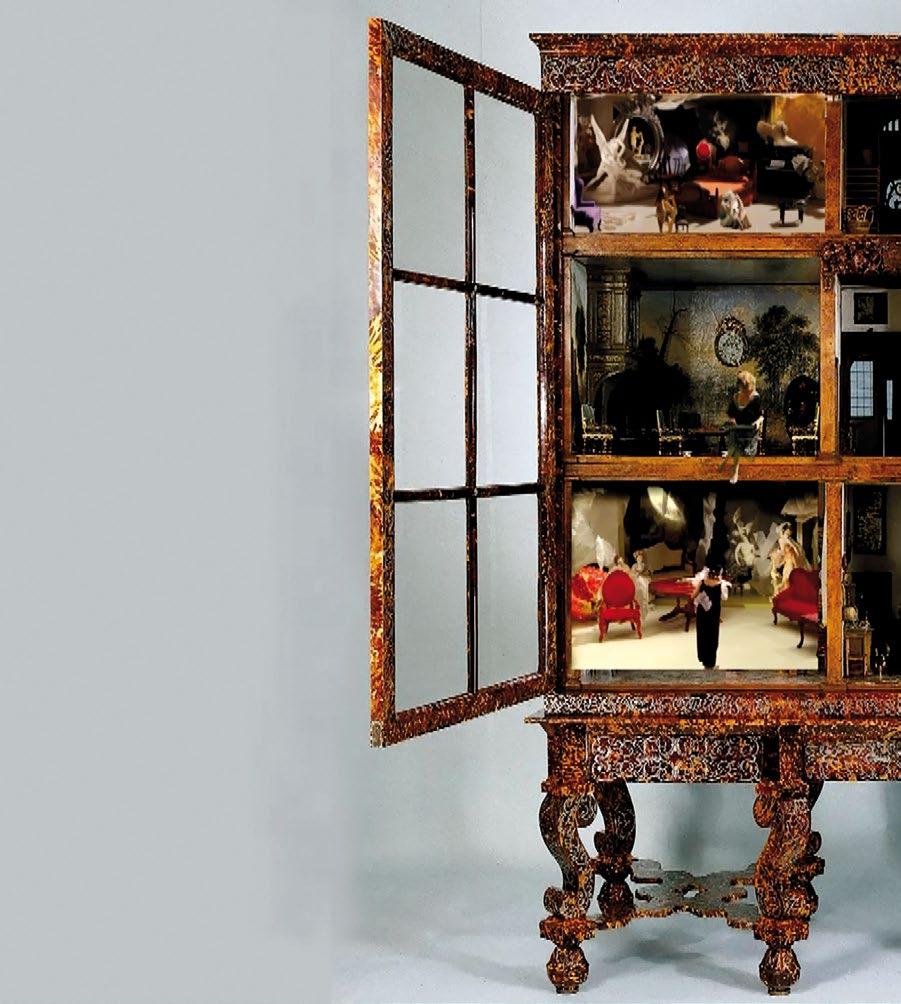
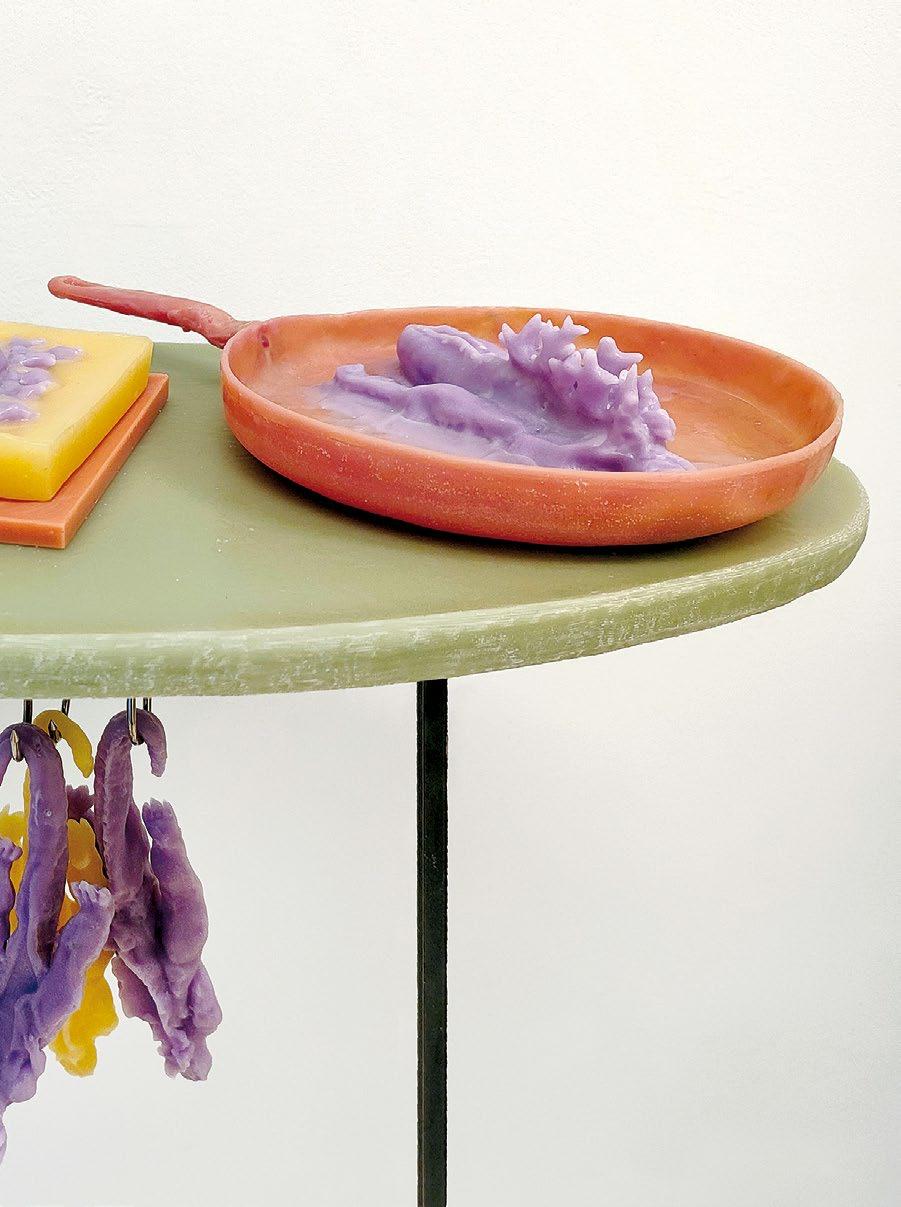
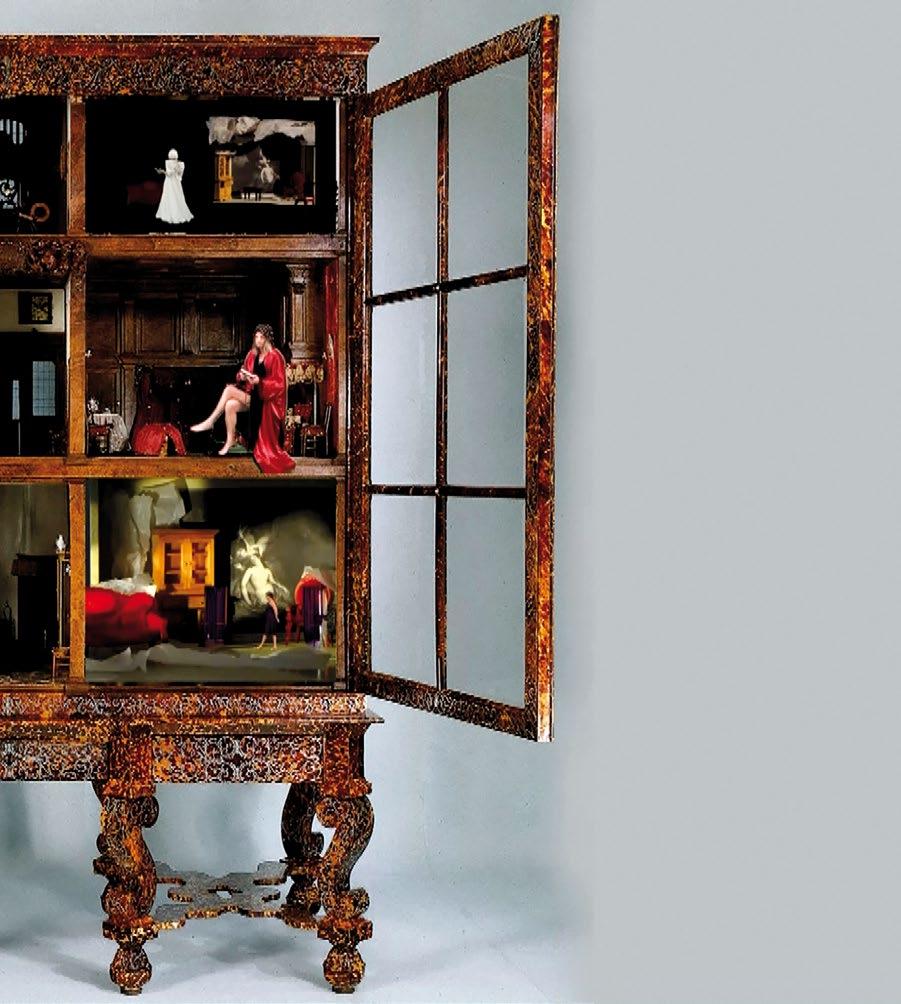
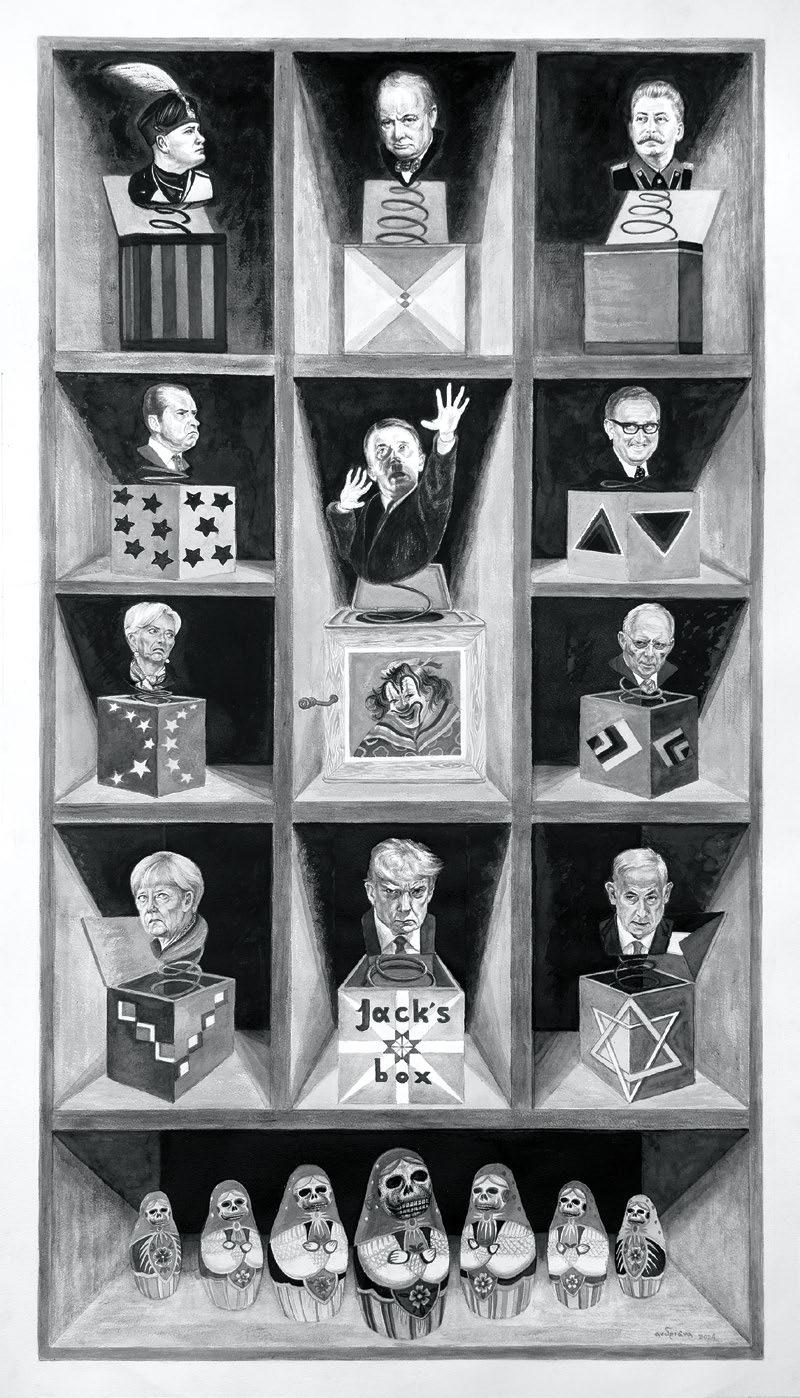
The multidimensional and evocative visual environment is open to multiple readings, interpretations, and approaches, creating a captivating space of coexistence and encounter – it is a multifaceted mirror reflecting aspects of human life. Emerging in Europe during the Renaissance, Cabinets of Curiosities came to be identified with a collecting frenzy, aesthetic pleasure and amazement through their wondrous and rare exhibits. These ranged from works of art andrelics to strange and “exotic” artifacts from distant cultures, alongside scientific tools and instruments, objects from the natural world, and items related to medicine, zoology, botany, gemology, mineralogy, and astrology, as well as to the realms of the occult, alchemy, and magic.
A modern Cabinet of Curiosities. One that weaves a complex tapestry of images and realities through works that cover a broad thematic spectrum (many directly reference historical collections of “curiosities” and “marvels”), opening portals to different worlds, times, and regions. The stories they tell, inventive and original, explore concepts such as life and death, nature and technology, vanity and paradox, violence and threat, myth and dream, erotic desire and libido. These stories are both strange and alluring – sometimes imbued with a surreal spirit, at other times serving as ecological or existential, social or political allegories, occasionally also carrying
αστακούς και καβούρια, μηχανές-«άνθρωποι», δράκοι και πρωτόγονες μάσκες· σύμβολα, νεκροκεφαλές και σκελετοί,
a lyrical, romantic sentiment, a playful disposition and a subversive sense of humor.
Everything has its place in a contemporary Cabinet of Curiosities: mythical creatures, tritons and sphinxes; legendary monsters (kaiju) of modern pop culture, such as small Godzillas; real, imaginary, mutated, or resurrected animals, dragonflies, butterflies and orchids “frozen” and entrapped within glass spheres; snake flowers and two-headed serpents; grenades transformed into spiders, wounded deer, landmine-sniffing rats and amber phalluses; crowns and diamonds crafted from pine needles, scales adorned with roses, red pigments, and spiders; fossils of indeterminate animate organisms from a primeval past; summer temples, shrines, golden iconostases, and theatrical stages featuring dinosaurs; “still life” faces adorned with flowers, lobsters and crabs; “human” machines, dragons and primitive masks; symbols, skulls and skeletons, totems and medieval Danses Macabres (dances of death); labyrinthine clusters of bodies and erotic encounters of grotesque creatures; figures originating from tarot cards or from the ancient cultures of Africa and pre-Columbian America; crimson dancers and righteous justices holding the scales of justice; unexpected rocky formations resembling genitalia; collections of antiquities, hybrid forms – micro-sculptures crafted from porcelain figurines and doll toys or collections of heads of dark and controversial historical leaders; everyday objects fashioned from asphalt; dreamy yet terrifying gardens of Eden; eerie landscapes as well as places inhabited by bizarre technological structures.
Paintings, prints, sculptures, constructions and videos –works remarkably diverse in style, materials, qualities, sensitivities, visual values and aesthetic preferences– densely occupy the space of the Museum, evoking a sense of horror vacui (fear of empty space). This sensation, after all, was central to all Cabinets of Curiosities. This is an exhibition that challenges the gaze to navigate pathways between art and nature, reality and imagination.
Άλεξ Μυλωνά έως τις 31 Αυγούστου 2025. Τον χώρο περιοδικών
εκθέσεων του Μουσείου στο Θησείο, στην Αθήνα, «καταλαμβάνουν» 78 εικαστικοί: Λένα Αθανασοπούλου, Γιώργος Αλεξανδρίδης, Άγγελος Αντωνόπουλος, Μαίρη Αντωνοπούλου, Αννίτα Αργυροηλιοπούλου, Μιχάλης Αρφαράς, Ανδρέας Βάης, Βασίλης Βασιλακάκης, Μπάμπης Βενετόπουλος, Ανδριάνα Βερβέτη, Ανδρέας Βούσουρας, Τάκης Γερμενής, Νίκος Γιαβρόπουλος, Λεωνίδας Γιαννακόπουλος, Μαρίνα Γκενάντιεβα, Γιώργος Γυπαράκης, Λυδία Δαμπασίνα, Μάρθα Δημητροπούλου, Χριστόφορος Δουλγέρης, Τζένη Δούπη, Ράνια Εμμανουηλίδου, Κατερίνα Ζαχαροπούλου, Μάριον Ιγγλέση, Διονύσης Καβαλλιεράτος, Αντιγόνη Καββαθά,
The exhibition “A Cabinet of Curiosities” is on display at MOMus-Museum Alex Mylona until 31 August 2025. The museum’s temporary exhibition space in Thiseio, Athens, is “occupied” by 78 visual artists: Giorgos Alexandridis, Angelos Antonopoulos, Mairy Antonopoulou, Annita Argiroiliopoulou, Michalis Arfaras, Lena Athanasopoulou, Manolis Baboussis, Theo Bargiotas, Lina Bebi, Mania Benissi, Emmanouil Bitsakis, Margarita Bofiliou, Fani Boudouroglou, Alkis Boutlis, Pantelis Chandris, Panos Charalambous, Giorgos Chatzispyrou (Looper), Dionisis Christofilogiannis, Elli Chrysidou, Lydia Dambassina, Martha Dimitropoulou, Chris Doulgeris, Tzeni Doupi, Rania Emmanouilidou, Panos Famelis, Marios Fournaris, Marina Genadieva, Takis Germenis, Leonidas Giannakopoulos, Nikos Giavropoulos, Giorgos Gyparakis, Marion Inglessi, Nikos Kachrimanis, Antonis Kapnisis, Aris Katsilakis, Dionisis Kavallieratos, Antigoni Kavvatha, Daphne Klagkou, Yannis Kondaratos, Alexandros Maganiotis, Thanos Makris, Dimitra Marouda, Panos Mattheou, Kyriaki Mavrogeorgi, Dimitris Merantzas, Christina Mitrentse, Eva Mourtzi, Nourako (Fanouris Moraitis), Nikos Papadimitriou, Antonis Papadopoulos, Xenia Papadopoulou, Aliki Pappa, Konstantinos Patsios, Natassa Poulantza, Vasilis Poulios, Periklis Pravitas, Lia Psoma, Ifigeneia Sdoukou, Nikos Sepetzoglou, Dimitra Siaterli, Zoe Sklepa, Miltos Skouras, Marios Spiliopoulos, Andreas Spiliotopoulos, Nikos Tranos, Giorgos Tsakiris, Giorgos Tserionis, Maritasa Tsimplaki, Filippos Tsitsopoulos, Kostas Tsolis, Dimitris Tzamouranis, Andreas Vais, Vasilis Vasilakakis, Babis Venetopoulos, Andriana Verveti, Andreas Voussouras, Maria Xinopoulou, Katerina Zacharopoulou. n
The paper sculptures are arranged rhythmically according to the room in which they are exhibited and parade through the space. They are assembled from various types of hard cardboard and other modeling materials.
The portrait of Apostolos F. Vettas is from
The objects that have thus emerged have now taken on the role of invoking every form of memory within events, which constantly gush from the fountain of the past into the present. The material that I present recounts my long-standing relationship with scenography. They are the dramatic “remnants-documents” - scraps that arise when the model of a theatrical set is designed and constructed. Everything is hidden and arranged in an anarchic way between personal moments found in the hours of composition and the secrets that have been kept from the texts and images that only the theater knows how to present. I kept the pleasure of constantly assembling what I did years ago in the workshop and then on stage. I have the art of the ephemeral as my talisman. It protects me in the battle with time. In the time that has passed and in the time that will come.

συνθέσεις που αναδύονται μέσα από την ισοπεδωτική κυριαρχία του μαύρου χρώματος. Τα ατελείωτα τάγματα στρατιωτών
With the “re-assembly”, therefore, of the various remains, new compositions in space and new conditions arise which, when properly lit, produce extremely interesting shadows on the walls of the rooms. The shadows praise and narrate to the viewer “hidden” proposals so that he can imagine a new dramaturgy in new theatrical spaces. Thus, a process of transformation emerged, that began to yield results when each unit-sculpture ended up hosting, like a manger, improbable incidents that seek to find a personal relationship with contemporary Greek reality. This resists the academic ethics of conventional theater and urges the viewer to define for himself/herself the place where he/she will see the object-sculpture and its shadows.
At the same time, they depict the “reportage” of destroyed cultural finds, theatrical landscapes, scenes, monuments, etc., as they have been ravaged by the “war news” and the climatic effects of violence, which flattens everything in its path.
In a turbulent era, in which the image of the destroyed environment of ruins is complicated with historically “inappropriate” architectural compositions that emerge through the flattening dominance of the black color. The endless battalions of soldiers who clash with each other, tear each other apart and triumph in the ruins of civilization.
So, I created a parade, in which the viewer naturally holds the privileged position of managing, dominating, choosing what he/she likes and what he/she doesn’t like. I chose the anthology of the battle of dragons and titans with the birds of paradise that melodramatically breathe in the ruins of large and small theaters and stage constructions.
Perhaps Escher is somehow sneaking around in my mind, distorting the truth, with a silent rudeness that plays provocatively with the conventional rules of visual perception, but the mythology of its image allows it.
So, inside the closed room, a sculpted scarecrow with a bird on top, which can passionately rotate, and a shell ancient theater emerged, tell us things that today’s people do not want to understand. n
WHERE & WHEN: The exhibition “Apostolos Vettas. Scenes made of paper” is hosted at MOMus-Museum of Modern Art-Costakis Collection in Thessaloniki, in Moni Lazariston, until May 18, 2025.


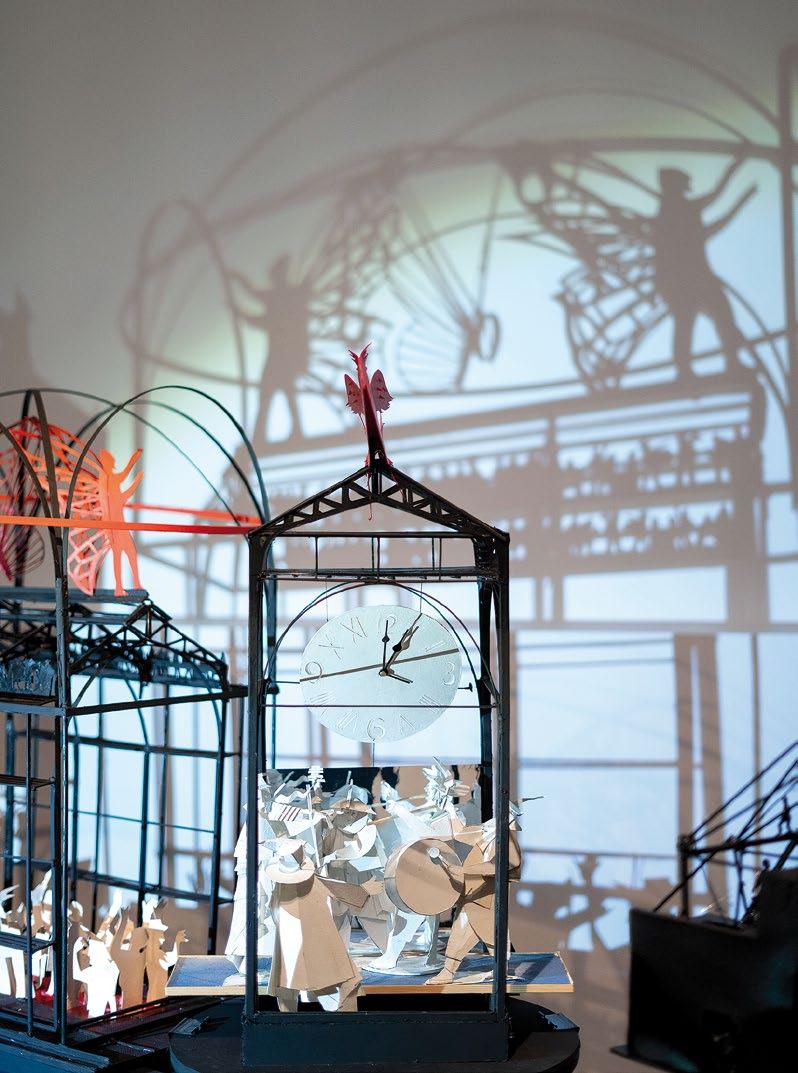

Ο
Φεστιβάλ
κ.ά. Έχει συνεργαστεί με τις σκηνές του Εθνικού Θεάτρου, του Κρατικού Θεάτρου Βορείου Ελλάδος (ΚΘΒΕ), της Εθνικής
Λυρικής Σκηνής, με τα Δημοτικά Περιφερειακά Θέατρα
Apostolos Fokion Vettas was born in Athens in 1945. He studied Architecture in Thessaloniki and did postgraduate studies in Edinburgh, Scotland (College of Art, School of Architecture, Herriot-Watt University). He lives and works in Thessaloniki. He is emeritus professor of Scenography in the Theater Department of the School of Fine Arts of Aristotle University of Thessaloniki (AUTH).
As an architect, he deals with issues related to the view of the theater space, its technical characteristics, form and function. Since 1981 he has collaborated as a scenographer with theater organizations and theater troupes in Greece and abroad. His scenographic works have been presented at the Festivals of Epidaurus, Athens, Dimitria, etc. He has collaborated with the National Theatre, the National Theatre of Northern Greece, the Greek National Opera. He has collaborated with the Municipal Theatres of Kalamata, Patras, Larissa, Volos, Kavala and Veria, with the Greek Art Theatre Karolos Koun, the “Techni’s” Experimental Scene in Thessaloniki and other troupes in the region as well as with private troupes in Athens.
In 2003 he was the curator of the Greek participation in the Prague Quadrennial for Scenography, which received a special honor “for the quality of the presentation”. For his work, he received several distinctions both in Greece and abroad. For his overall work, he was honored by the Study and Research Center of the Hellenic Theatre and the Theatre Museum with the Panos Aravantinos prize. He has at times served as president of the National Theatre of Northern Greece (1995-1997), of the Theatre Department of the Faculty of Fine Arts of the Aristotle University (1997-1999 and 2003-2005), dean of the Faculty of Fine Arts of the Aristotle University (2000-2003), and of the Department of Cinema (2006-2007).
He was a member of the advisory committees of the Greek Ministry of Culture on grants for the independent theater. He was a member of the board of directors of the Hellenic Center for Theater and Dance, involved in the operation of the Municipal Theatres. n
Kyriaki Goni examines the political, emotional, and environmental faces of technology using web, drawing, video, sound, and text. For over a decade her installations have created alternative ecosystems and collective experiences that bridge the local with the global, and the imaginary with the scientific. ΣΥΝΕΝΤΕΥΞΗ/INTERVIEW
N. Vassos
Merakos
You express yourself through experiential art, if I may call it that? Using a variety of media, you explore the political, emotional, and environmental faces of technology, and as such create art that speaks to our contemporary world. What prompted you to follow this creative path?
My creative path evolved naturally over the years because I had the freedom to experiment with various mediums and concepts. I’m interested in how technology transforms the world but more so how it’s experienced and the new narratives it presents at the physical level, on our planet, history, and memory. While my work is rooted in the present it unfolds from the past, present, and potential futures, hence intertwines layered tempor-
εναλλακτικές θεωρήσεις; Τα δίπολα θεωρούνται τυπικά εργαλεία κατανόησης στον δυτικό κόσμο, αλλά, ευτυχώς, τα έργα
alities. Similarly, many of my projects begin with defined geographies, histories, and communities, however they eventually interconnect with global systems of technology and power. Perhaps it’s our current times, its technologies, crises, and possibilities that has in some way paved my creative outlook.
Does bipolarity exist in art such as real Vs. imaginary, imaginary Vs. scientific, or local Vs. global? Is it worth drawing such distinctions?
How do you engage with and express these contrasting perspectives in your work?
In the western world, bipolarities are often fundamental tools that help us make sense of things. Fortunately, art frequently transcends these boundaries, generating new meanings and unexpected connections. In my work, I aim for art to function as a web of interconnected systems, i.e. technological, physical, mythological, geopolitical, where these distinctions serve more as tools for exploration and poetry rather than fixed divisions. Personally, I view these oppositions as tensions that foster a space for experimentation. My work isn’t confined to bipolarities like the “imaginary” versus the “scientific”; instead, it deconstructs, shifts, and uses dualities to present new narratives and imagine alternative worlds.
Especially in times dominated by polarization, populism, and obscurity, art isn’t meant to choose between opposing poles but to create bridges between them. To create something in that space between.
You’ve received awards and accolades both nationally and internationally, and your works are featured in private and institutional collections. Is there such a thing as having reached a “ceiling” for an artist? A moment when you feel, “I’ve accomplished everything I set out to do?”
If there is a “ceiling,” it’s one that is constantly shifting. For me, creation isn’t a linear path to a peak; it’s a dynamic dialogue between my inner and outer worlds, a continuous confrontation, search, one that’s often chaotic. It’s never something that’s simply “finished.” It’s a cycle, a living process where each project triggers new questions, needs, and forms of communication.
νέες ανάγκες, νέες μορφές επικοινωνίας. Η αναγνώριση
Recognition and awards are important, but they don’t mark the end of a journey. They’re brief milestones along a path that continues. I’m always grateful when my work and dedication are acknowledged, but the very next day I’m back at the studio.
The way I work, is to experiment with new tools, platforms, and scientific or technological approaches, where the thought of having “done it all” is impossible, and fortunately so! Perhaps if there is a limit, it’s not in the work itself, but in the ability to continue to question, listen, observe, and tell stories. It’s not always easy to keep your senses on high alert, even when you’re a visual artist. Like any profession, visual art involves areas unrelated to creativity, such as managing the studio’s finances, handling procedural and administrative tasks, and dealing with demands that other fields take for granted. I’ll say this: as long as there are questions, creation will never cease. n
For more information, visit https://kyriakigoni.com/ or follow @kyriaki.goni.studio on Instagram.
the right > Κyriaki Goni: “In the western world, bipolarities are often fundamental tools that help us make sense of things.”

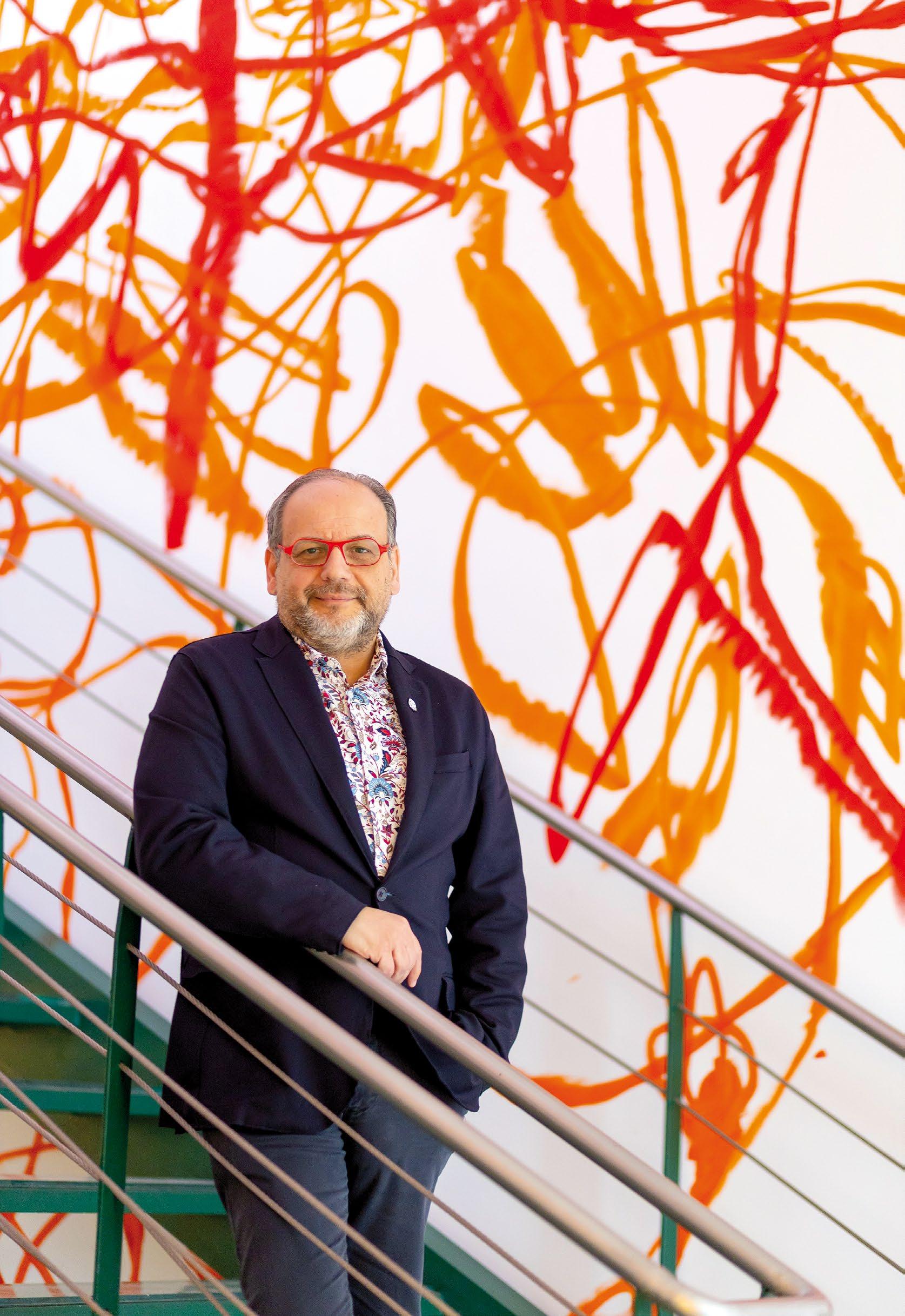
A charismatic communicator, Prodromos Monastiridis is a passionate and active citizen. He loves Thessaloniki unconditionally but has high expectations and works tirelessly to support the city in its every endeavor. He also serves as the Chairman to the Board of Directors of the Thessaloniki Convention Bureau.
Culture being your focus for many years, tell us about your connection with MOMus, both as an active citizen and representative of the Thessaloniki Convention Bureau (TCB), another key organization in the city.
MOMus speaks to me on a personal level, but more importantly, its location by the port, the International Fair, and the Lazariston Monastery creates a connection between the museum and the entire city. This means that no matter where you find yourself in Thessaloniki, you’re always near an exhibition, a presentation, or simply a great spot to enjoy a coffee. Additionally, MOMus is a member of the Thessaloniki Convention Bureau, adding a unique conference venue to the city’s offerings.
You’ve witnessed MOMus’ progression over the years, what key milestones would you say are the most emblematic moments that have left a lasting impact on the city? Is there a particular story or experience that stands out?
There are two key moments that stand out to me. The first is the acquisition of the Costakis Collection, which marked a major milestone for the museum. At the time, I don’t think we fully grasped its significance or the added value it brought to the city or the opportunities it held. Personally, I only truly discovered its wealth and immense potential after being fortunate enough to attend a private guided tour by Maria Tsantsanoglou, a director of MOMus.
“MOMus, like other city organizations, has demonstrated a strong belief in the power of COLLABORATION and consistently invests in it. Each BIENNALE it organizes is a clear testament to this.”
Years later, the collaboration with the Macedonian Museum of Contemporary Art and the establishment of MOMus provided a foundation that enabled this new entity to evolve into a powerful force for artistic intervention in contemporary art, something the city undeniably requires.
Do you believe that art and culture have the power to guide us toward becoming better people in our everyday lives? How much truth is there in that? And what kind of public response have you received?
Art, in all its forms, serves as a window through which we can see, feel, and hear the world from a different perspective. You don’t need to be an expert to appreciate a painting or allow music to take you on a journey. After all, art has the power to influence and shape the human experience in countless ways. In this respect, art can help us become better people in our everyday lives, because it encourages us to explore new perspectives, reflect on our values, and leave a positive impact.

This interaction creates a deeper understanding of others and strengthens our connection with the society around us. Art acts as a catalyst for personal and social growth because it encourages empathy, acceptance, and solidarity.
It’s a dynamic and ever-evolving relationship that intentionally engages the public of Thessaloniki. There is always room for improvement to ensure that audiences engage with art beyond the superficial interactions that often occur to truly appreciate and evaluate it as it deserves.
In light of MOMus’ efforts towards renewal and greater outreach, do you see opportunities for collaboration with other city organizations that could further promote Thessaloniki’s modern identity? What initiatives or changes would you like to see take shape?
MOMus, like other city organizations, has demonstrated a strong belief in the power of collaboration and consistently invests in it. Each Biennale it organizes is a clear testament to this. The exhibitions, artists, and themes it selects present a more modern Thessaloniki. A recent example is the DJ set at the Thessaloniki International Fair, which attracted people I had never seen before at a museum.
I look forward to MOMus continuing to shake things up when the waters become still, and to curating unique exhibitions and events that will inspire the whole city to get involved.
Could Thessaloniki become an even more significant destination, attracting an audience that is focused on contemporary art and creativity in all its forms? Do you believe the city is ready for this shift?
The city has already demonstrated its potential as a destination, steadily rising in both visitor numbers and conference rankings each year. However, there is still room for growth in the cultural tourism sector. While all key elements are in place—such as MOMus, the Concert Hall, and the Thessaloniki State Orchestra—these institutions have yet to fully make use of their potential for external visibility and sustainable engagement outside the city.
It’s time for Thessaloniki to develop a clear strategy to build on its cultural presence. To make this a reality, strong support and collaboration between the private and public sectors are essential. This is something I truly hope will come to fruition soon.
What is your personal perspective on contemporary art? Which artists do you admire the most? And, on that note, are there specific moments or exhibits at the MOMus museums that have particularly captivated you?
Personal views of contemporary art can be highly subjective and varied yet we can agree that it often seeks to reflect society and the challenges we face, prompting us to engage in reflection and dialogue.
As far as artists go, there are many who have influenced the contemporary art scene, such as Yayoi Kusama, Olafur Eliasson, and Ai Weiwei. Each has created works that provoke deep thought and evoke emotional responses that differ depending on the viewer. They all bring a unique perspective, intertwining their personal narratives with larger social issues.
As for MOMus and its diverse spaces, there are many aspects that can captivate you. However, I would highlight its latest addition: the MOMus Art Café. It has become a must-visit spot and a daily favorite of mine. n
At MOMus gift shops, you’ll find everything you need to spoil yourself and loved ones. Browse a selection of practical, highly aesthetic items, each capturing the essence of pure joy and the beauty of life.
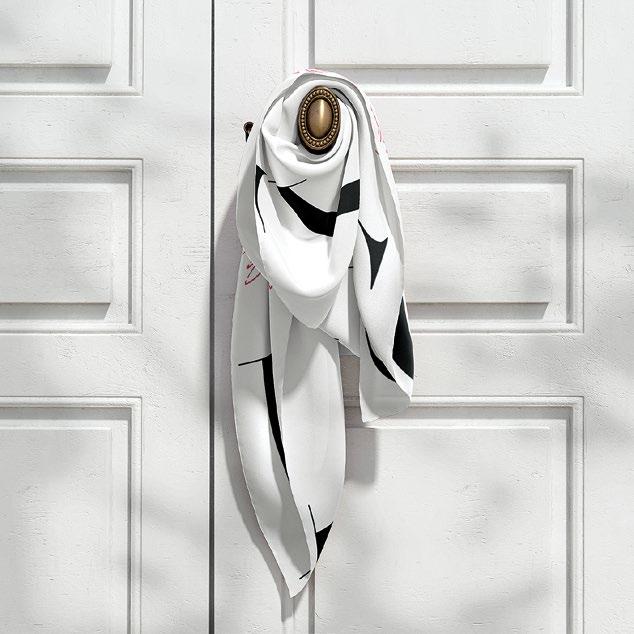

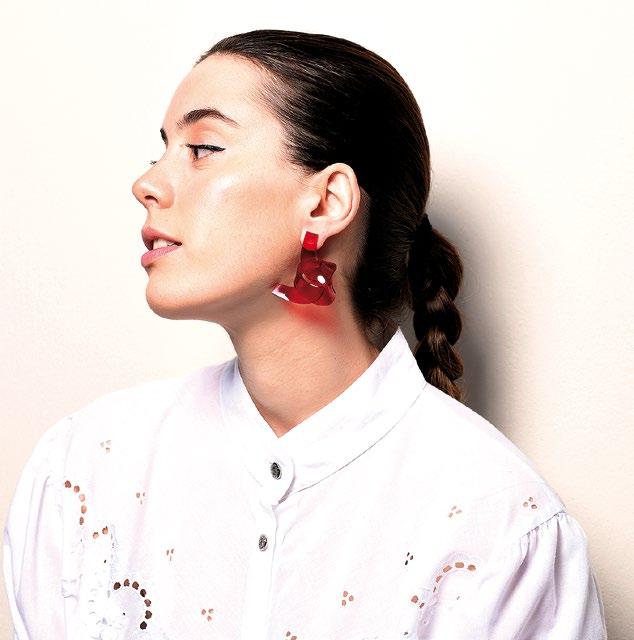
IOLAS POCKET SCARF. A premium-quality silk scarf created in partnership with the Mantility scarf gallery and the Tsiakiris Silk House in Soufli. This exclusive design by Mantility is inspired by archival materials from the Alexandros Iolas collection at MOMus-Museum of Contemporary Art.

of

Laminated magnetic bookmarks, featuring artworks by Lyubov Popova and Solomon Nikritin from the Costakis Collection at MOMus-Museum of Contemporary Art.

Available at: MOMus-Museum of Modern Art Gift Shop.

NOTEBOOKS. A5 notebooks with a sleek leatherette cover and white, lined pages. Available in four colors (black, orange, fluorescent blue, and fluorescent yellow), each featuring the #MOMus Contemporary logo on the cover.

Τιμή/Price: 10 ευρώ/euros

“SCENES. NOTES ON THE ART AND TECHNIQUE OF SCENOGRAPHY.” A two-volume illustrated encyclopedia dictionary by Apostolos F. Vettas. A true lifetime achievement, this work is written in a clear and accessible style, making it an educational guide for young aspiring theater professionals.

Τιμή/Price: 50 ευρώ/euros
volumes)
MOMus. Available at: All MOMus Gift Shops.
This bilingual catalog accompanies its namesake exhibition, showcasing over 100 works and archival material from the Costakis Collection at MOMusMuseum of Modern Art.



CHILDREN’S EDITION: “TRAINS AND MARMELADES”. This edition provides young readers engaging activities and tools to explore the story behind the works of the Russian AvantGarde. Suitable for all ages, with children aged 5-7 best enjoyed alongside an adult.

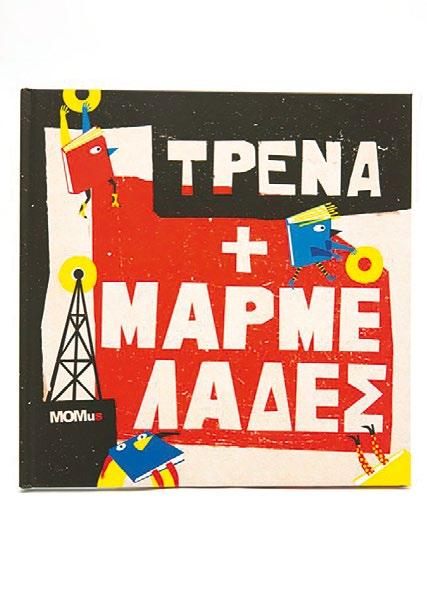
ΜΟΛΥΒΙΑ.
το logo #MOMus
Contemporary. Κυκλοφορεί
χρώματα (πράσινο, μπλε, κίτρινο,
ροζ). PENCILS. Sharpened pencils, featuring the #MOMus Contemporary logo. Available in five colors: green, blue, yellow, orange, and pink.

Τιμή/Price: 1 ευρώ/euro
Available at: MOMus-Museum of Contemporary Art store.

(1993). POSTER: ALEKOS FASSIANOS, “SMOKING LADY WITH MIRROR”. Museum-grade print featuring Alekos Fassianos’ iconic work “Smoking Lady with Mirror” (1993

Τιμή/Price: 15 ευρώ/euros
Available
of Contemporary Art Gift Shop.
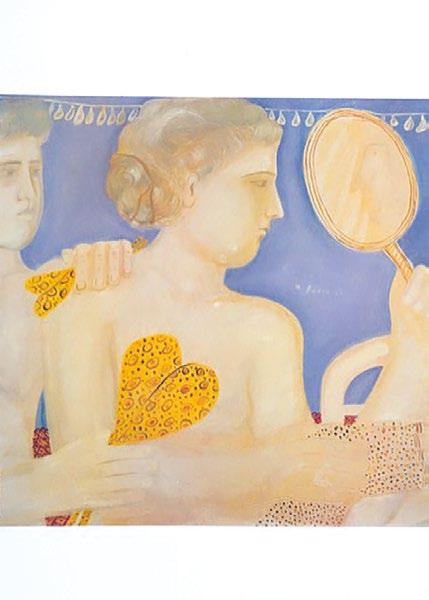
CATALOG: “FRED BOISSONNAS AND THE MEDITERRANEAN. A PHOTOGRAPHIC ODYSSEY”. The iconic catalog from the namesake exhibition, hosted at MOMusThessaloniki Museum of Photography. Fred Boissonnas, portrait photographer and head of an acclaimed photography studio in Geneva, was at the height of his career when a trip to Greece changed his life. Τιμή/Price: 20

Available at: MOMus-Thessaloniki Museum of Photography Gift Shop.
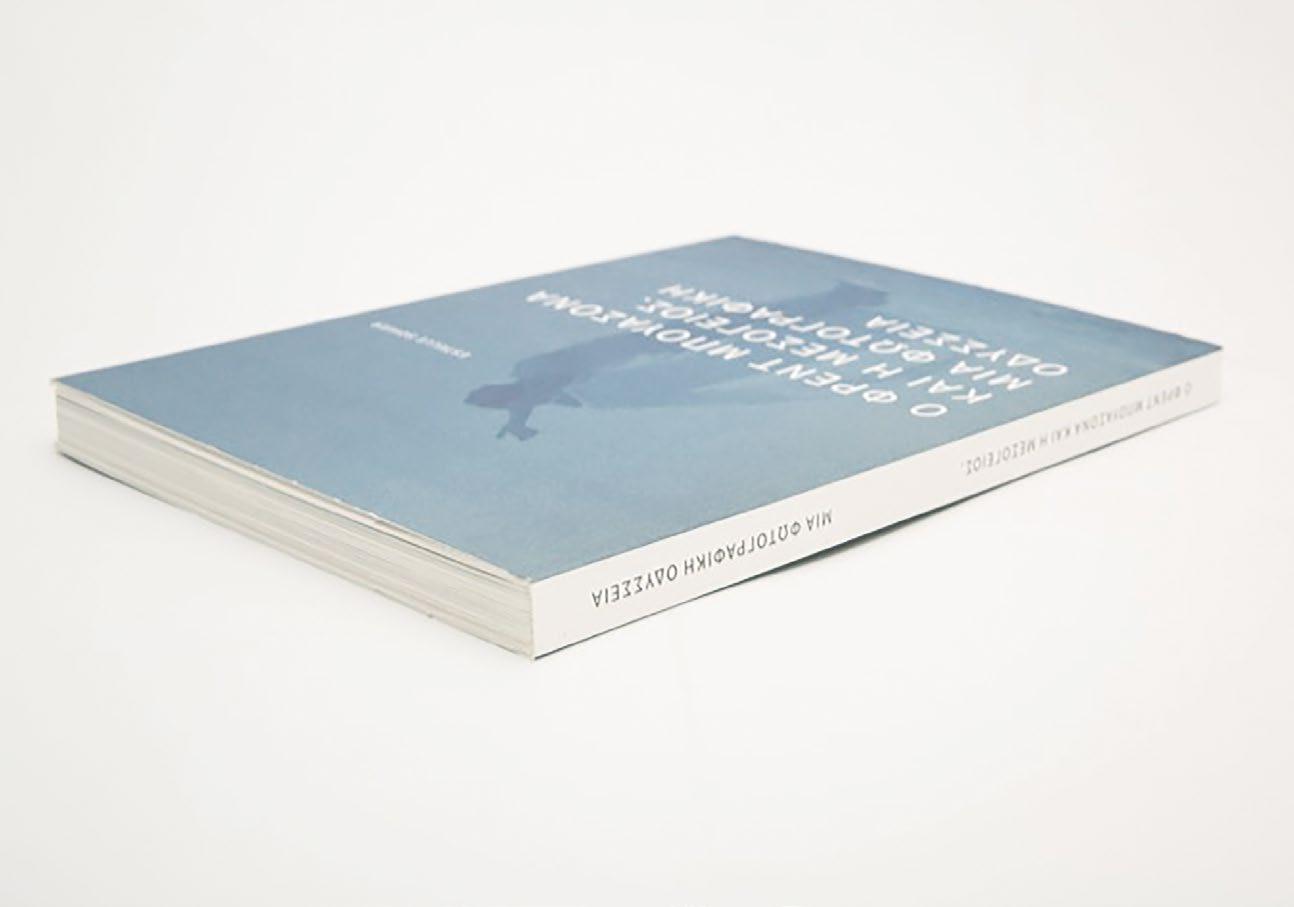
fine art archival paper 308
21x 25 εκ.). CARTON: “NONOBJECTIVE COMPOSITION”. Featuring the namesake work by Ivan Kliun (c. 1917) from the Costakis Collection. Printed on highquality 308 g/m² fine art archival paper. (Dimensions: 21 x 25 cm).

Available at: MOMus-Museum of Modern Art Gift Shop.

CATALOG: “ALL HERE! 50 YEARS OF DEMOCRACY”. This catalog features works by four of Greece’s most influential post-war artists (Kaniaris, Alitheinou, Katrakis, and Tassos) from the equivalent exhibition at MOMus-Museum Alex Mylona.

MOMus. Available at: All MOMus Gift Shops.
